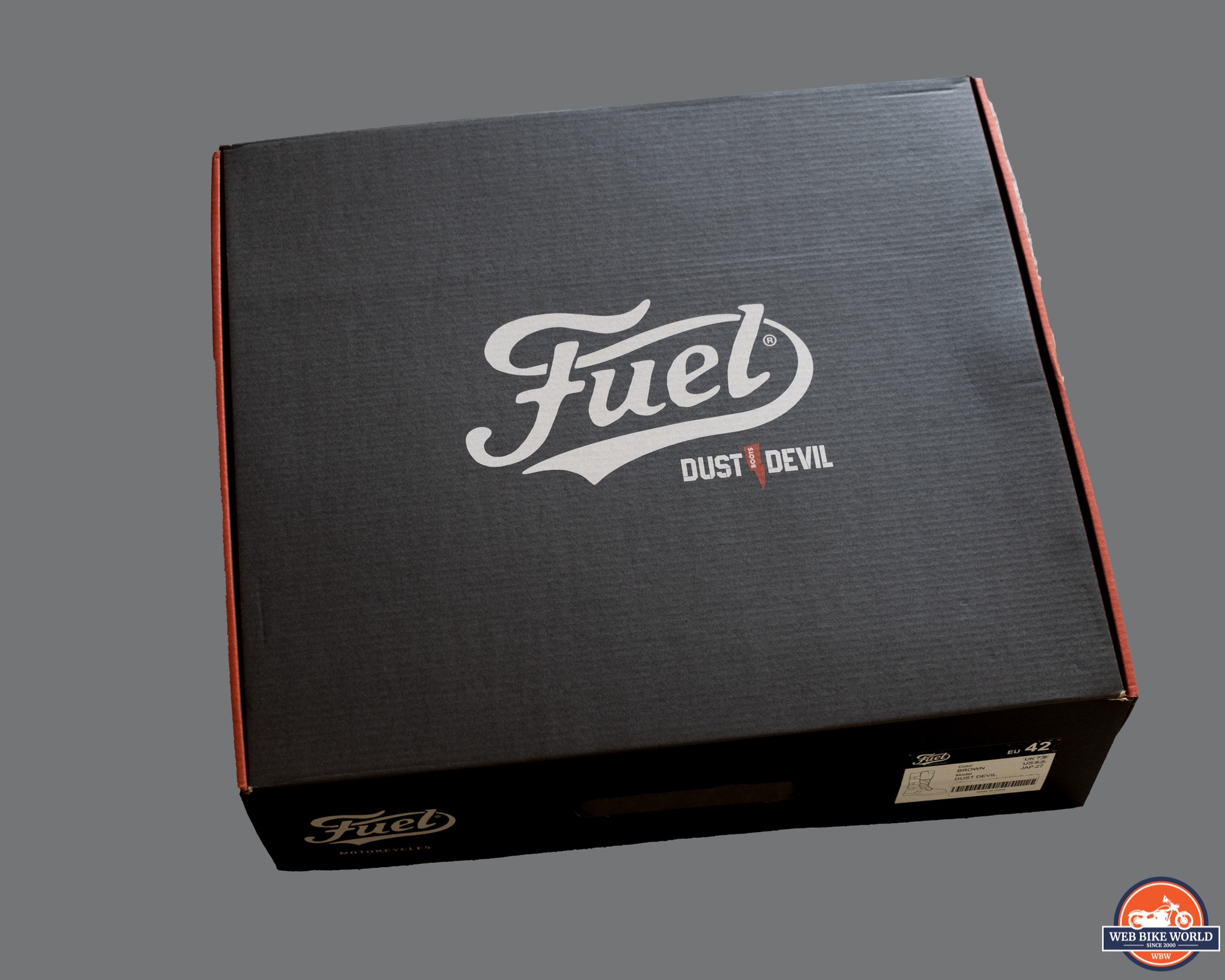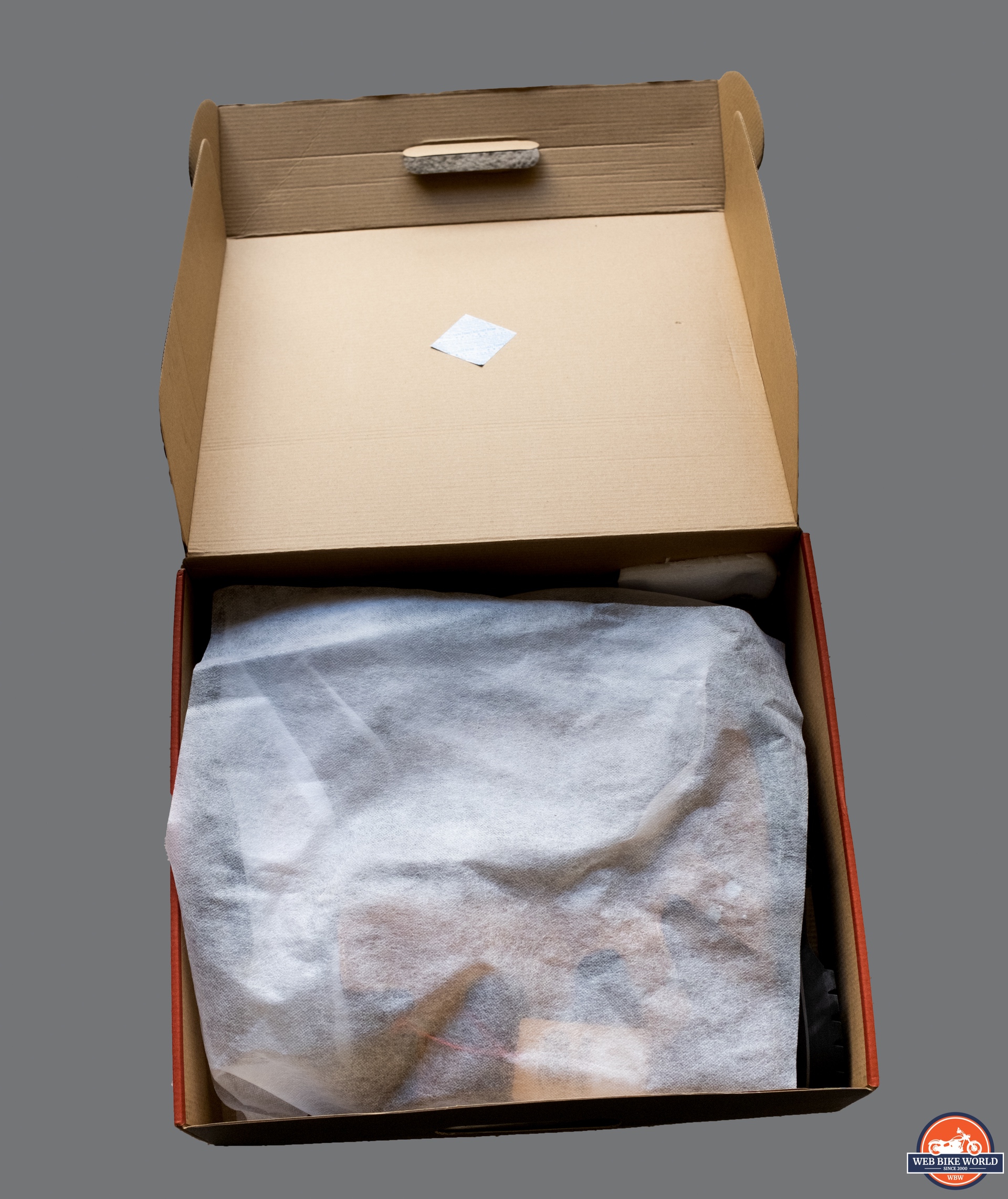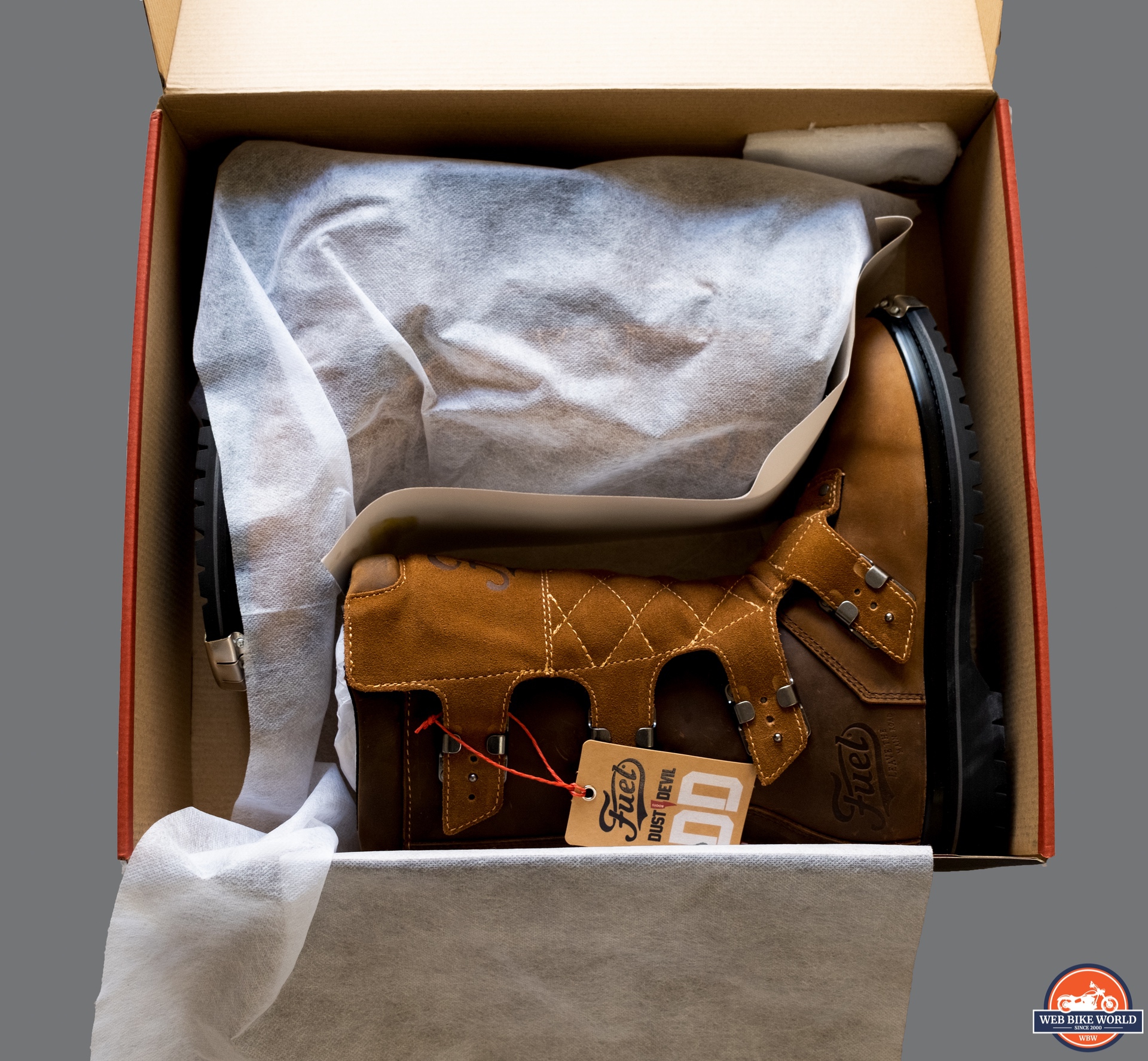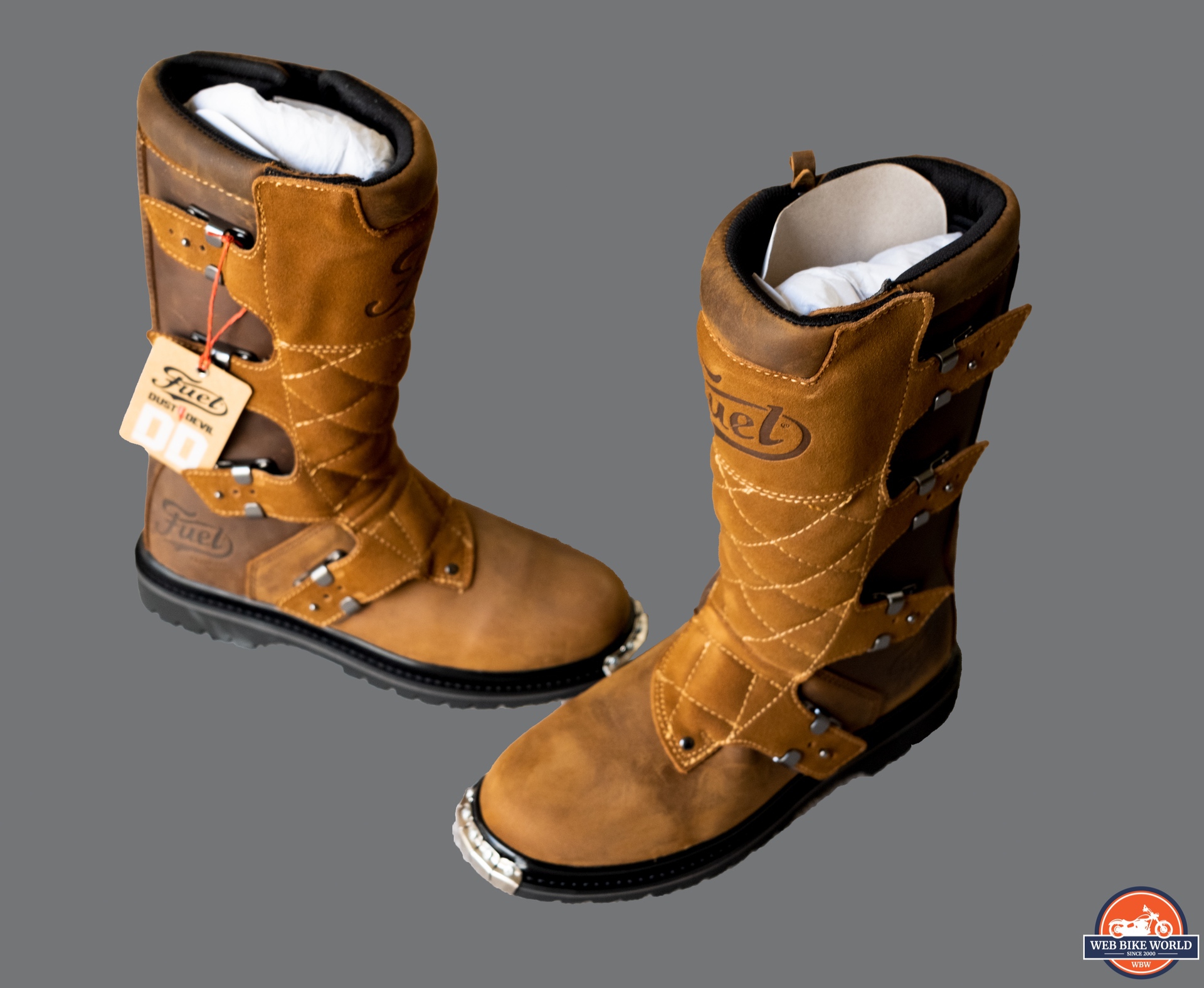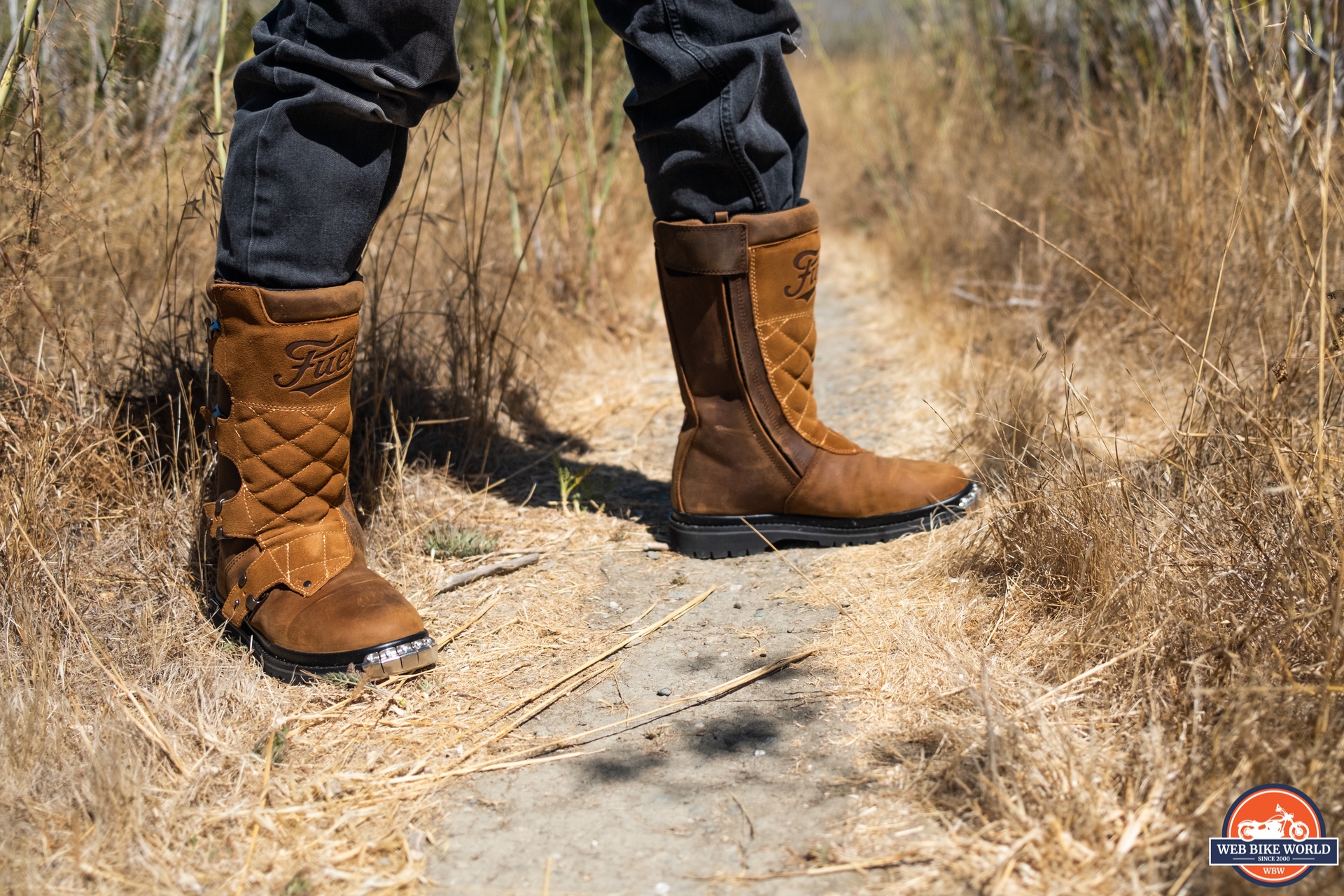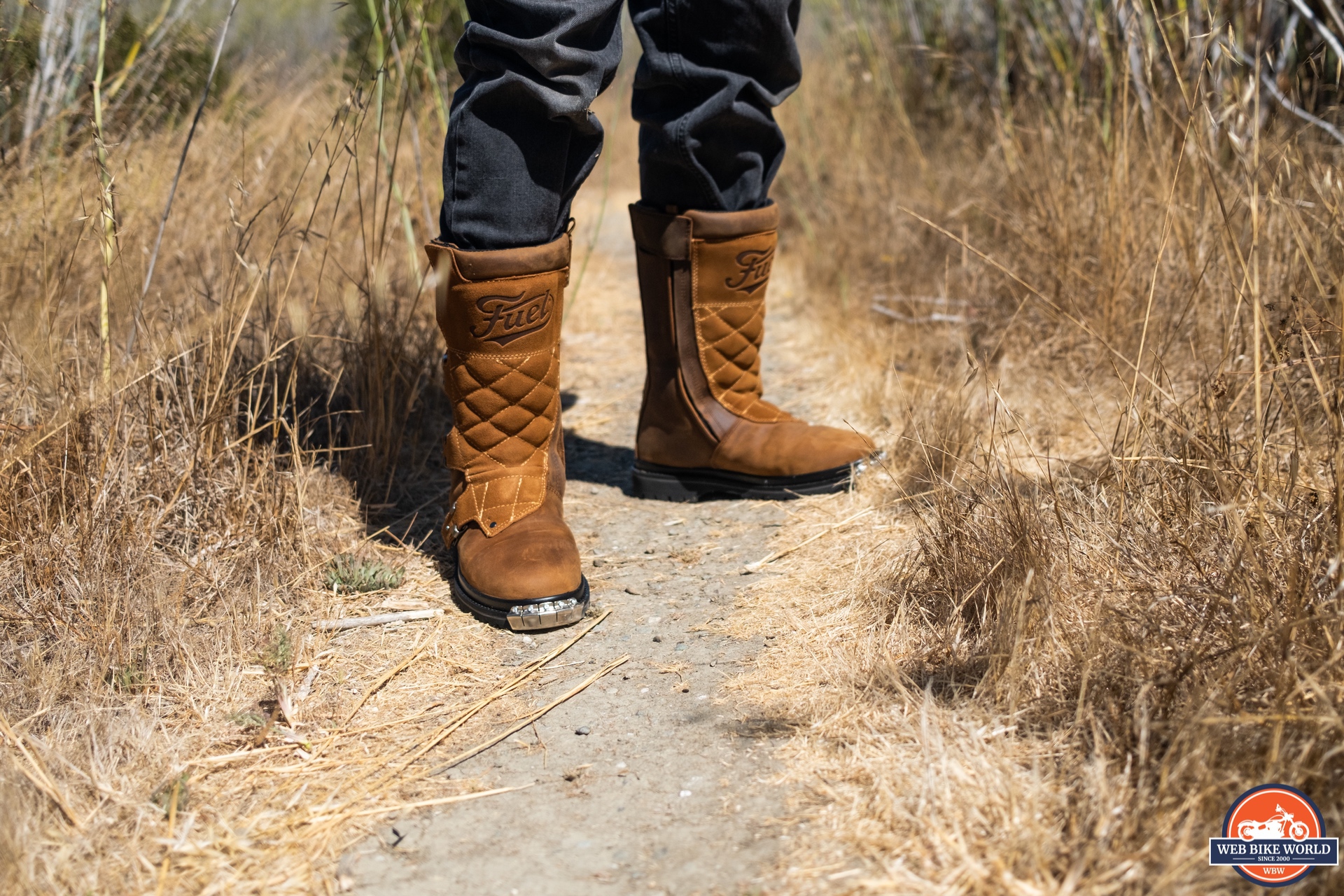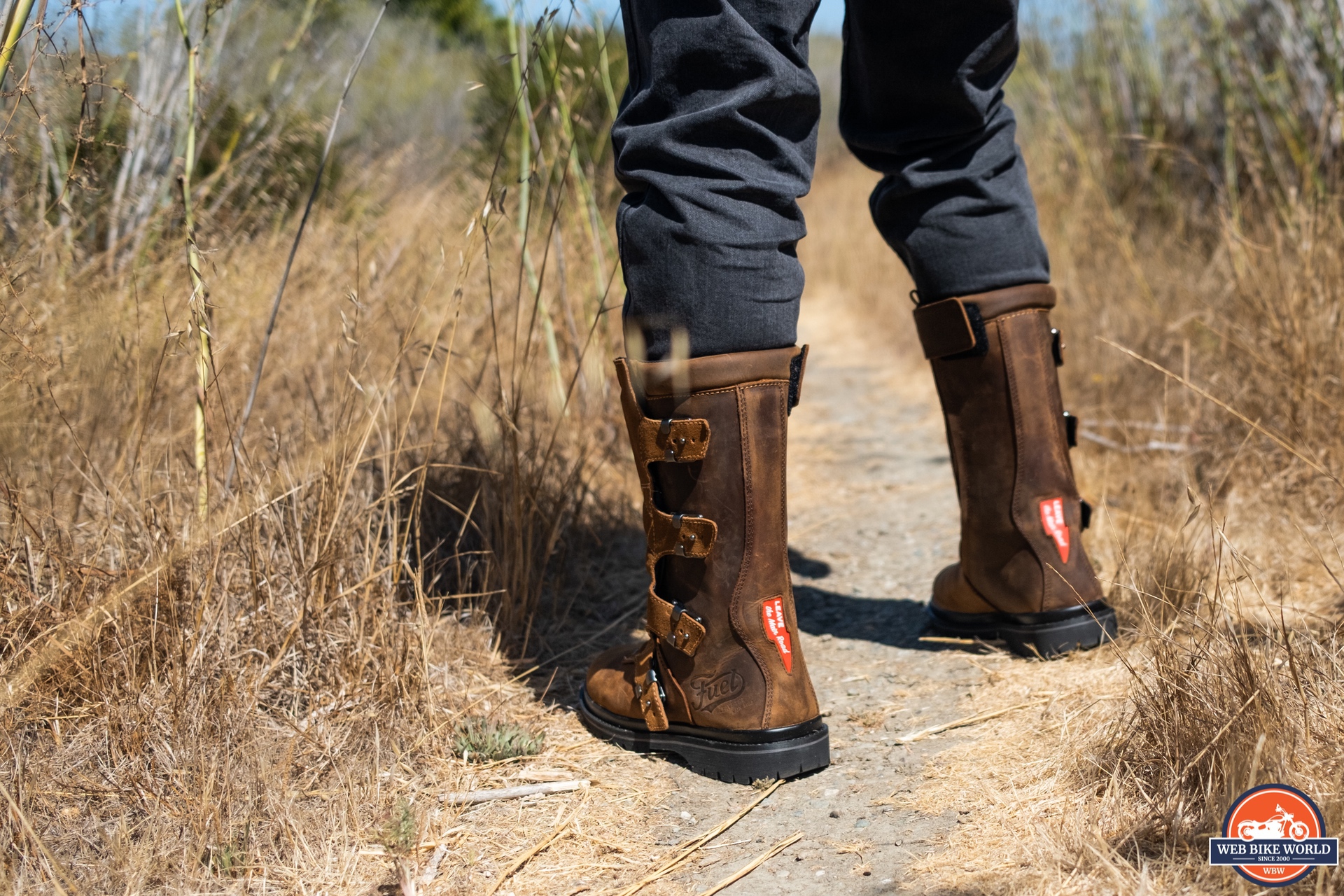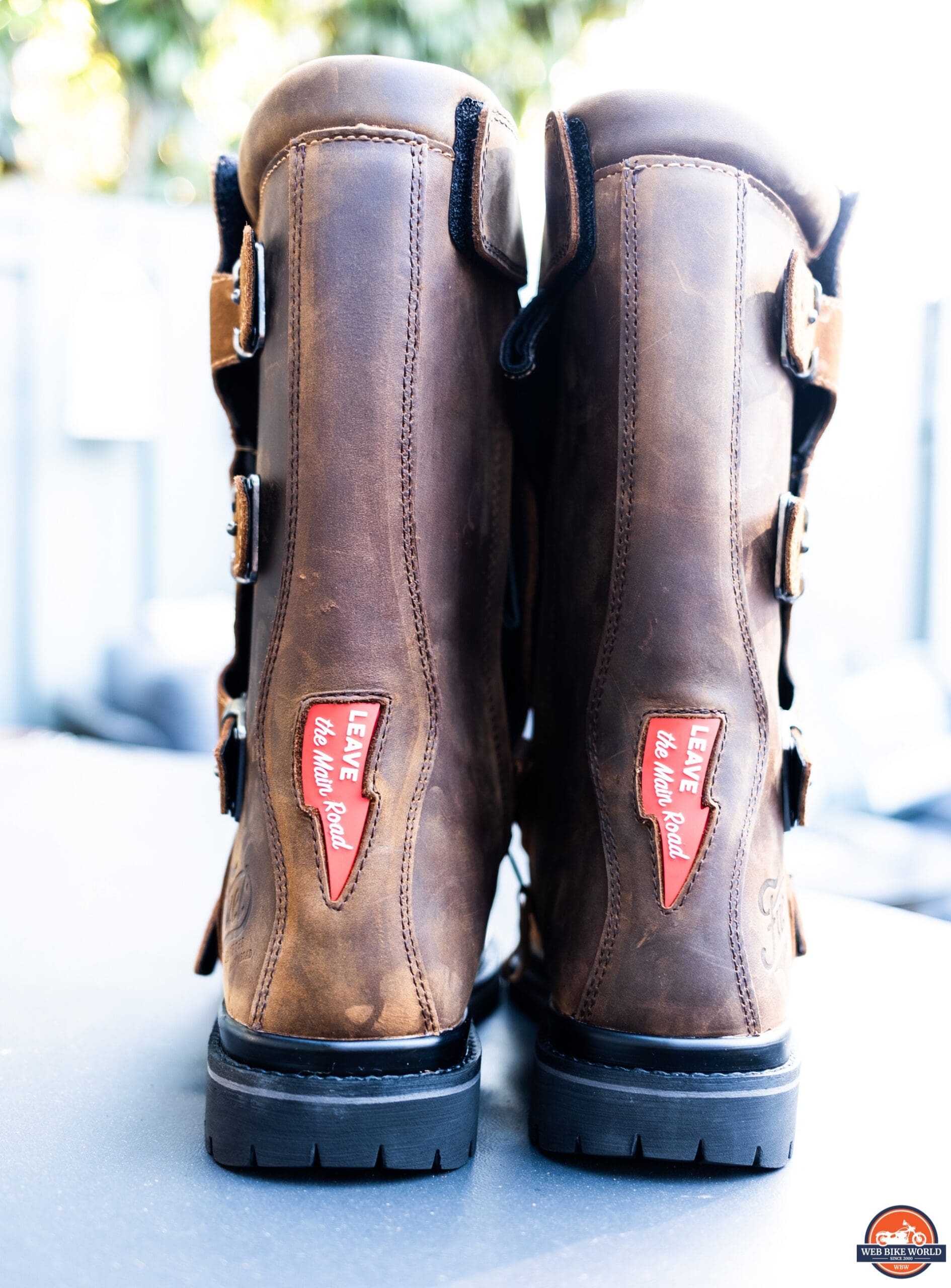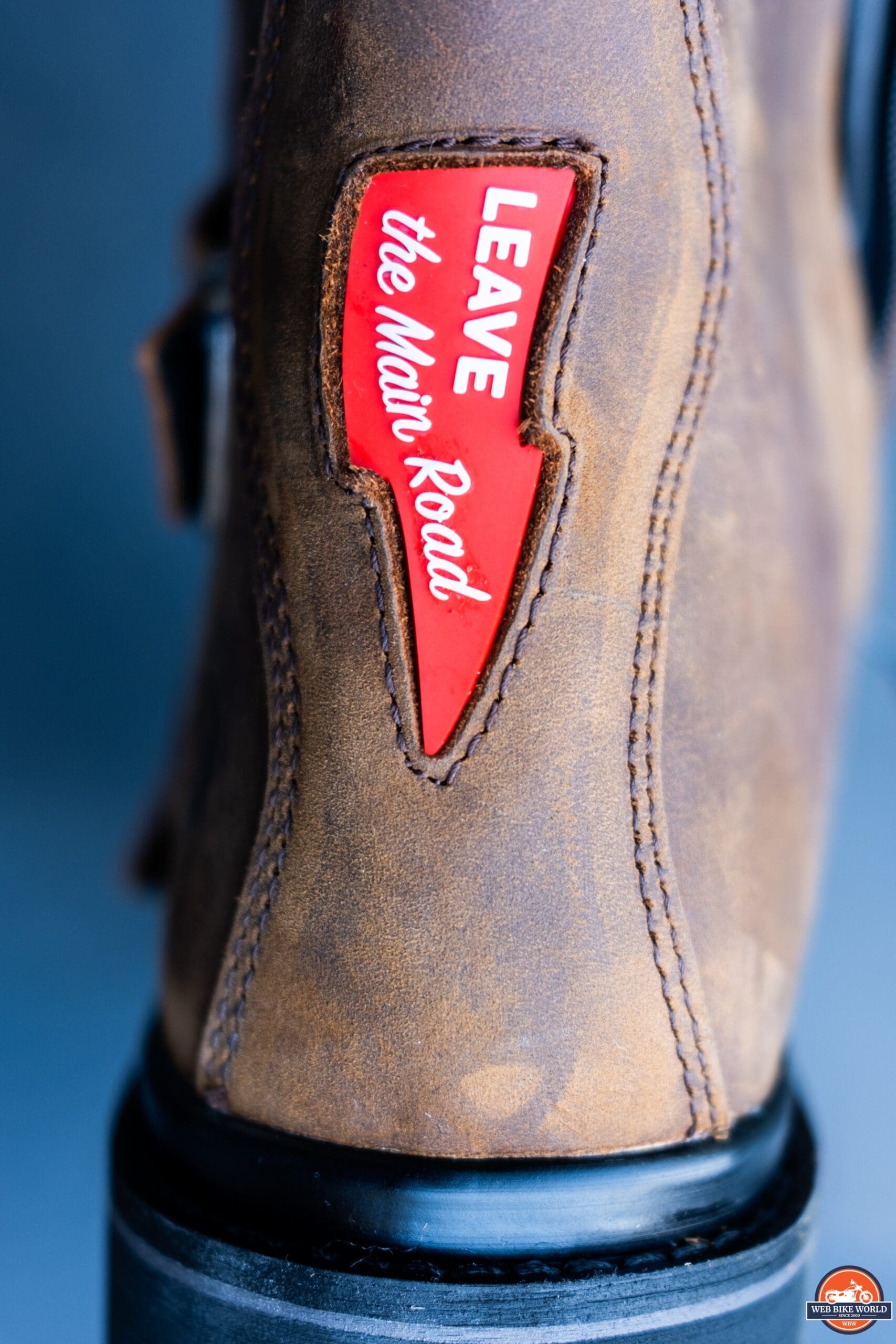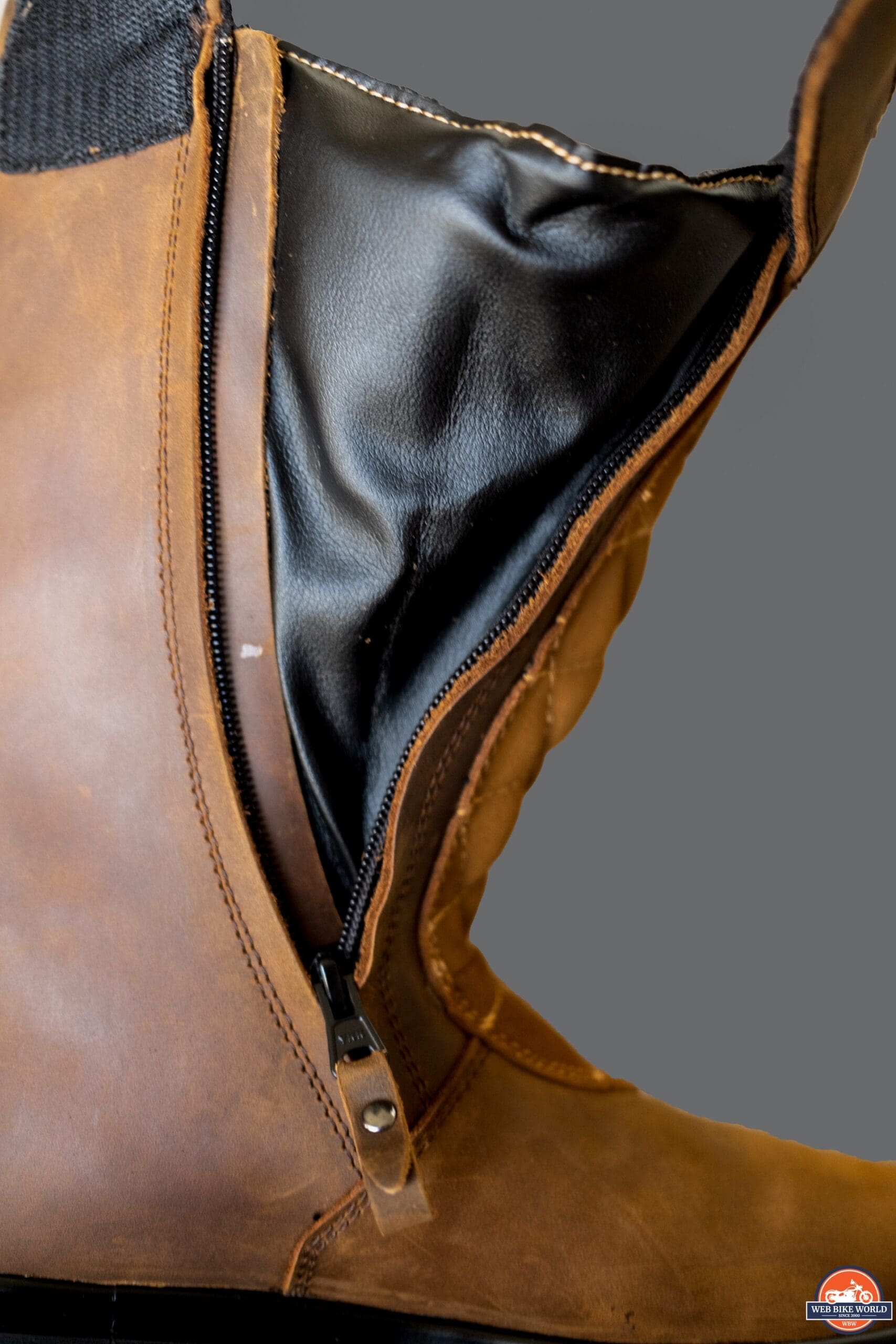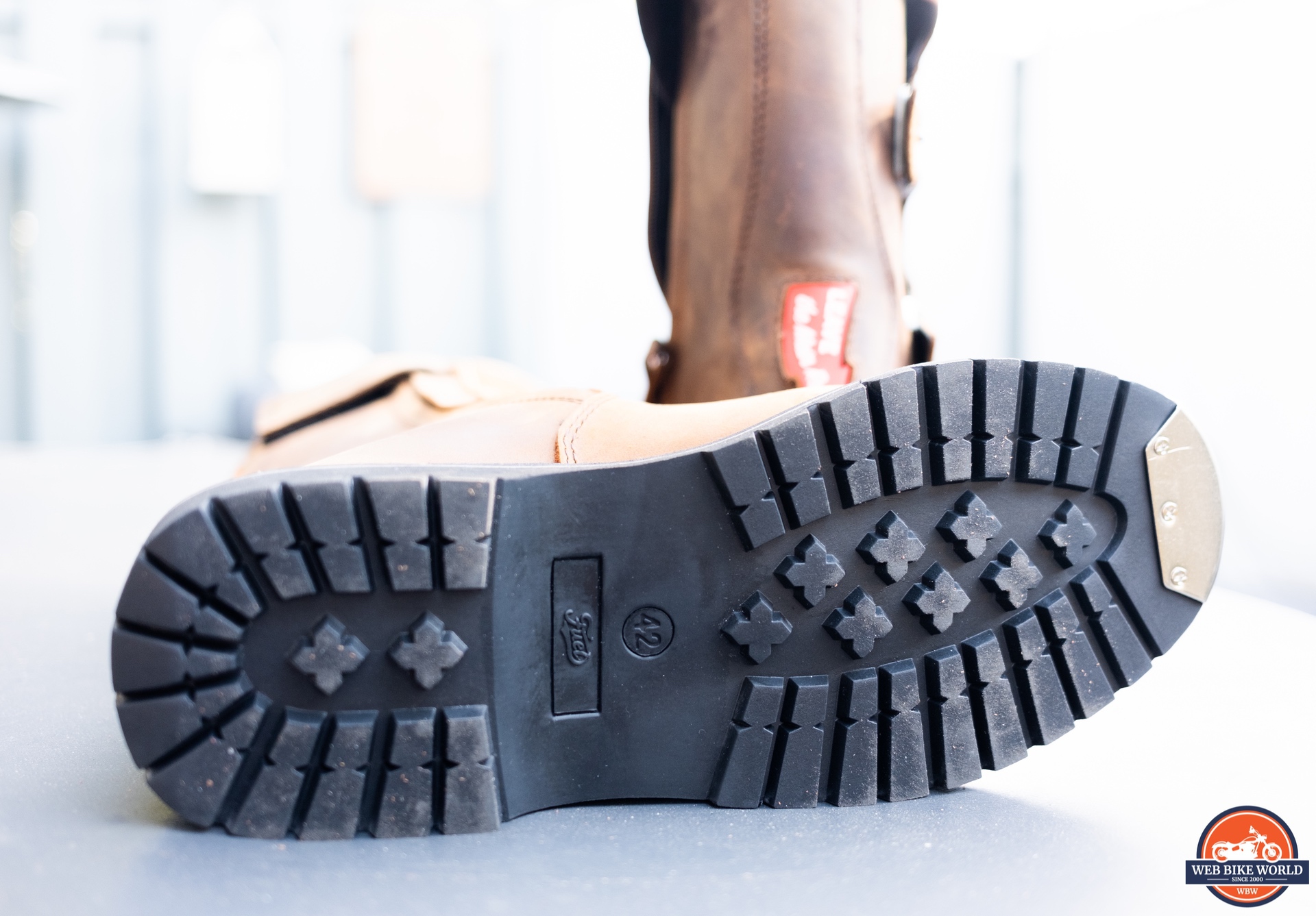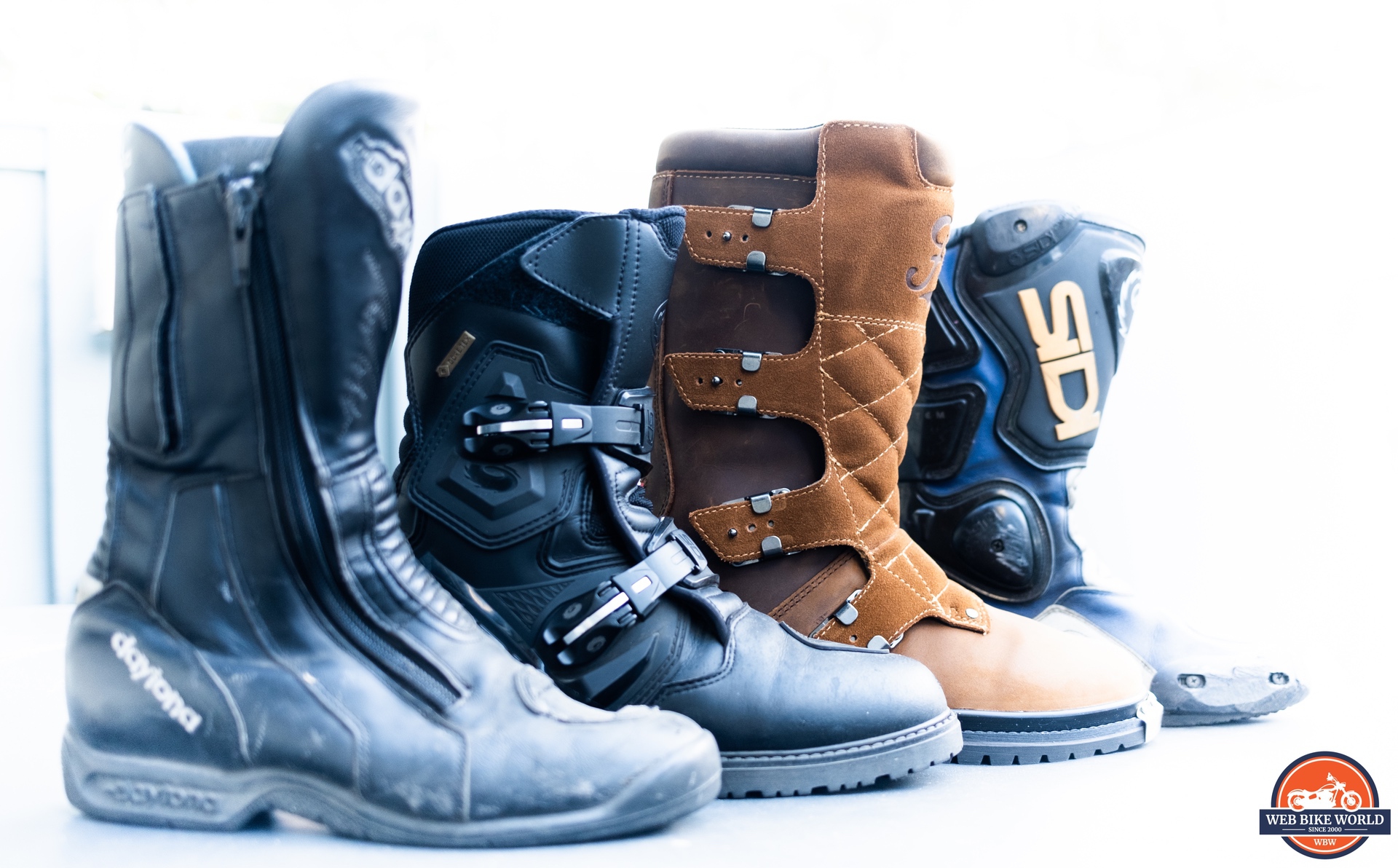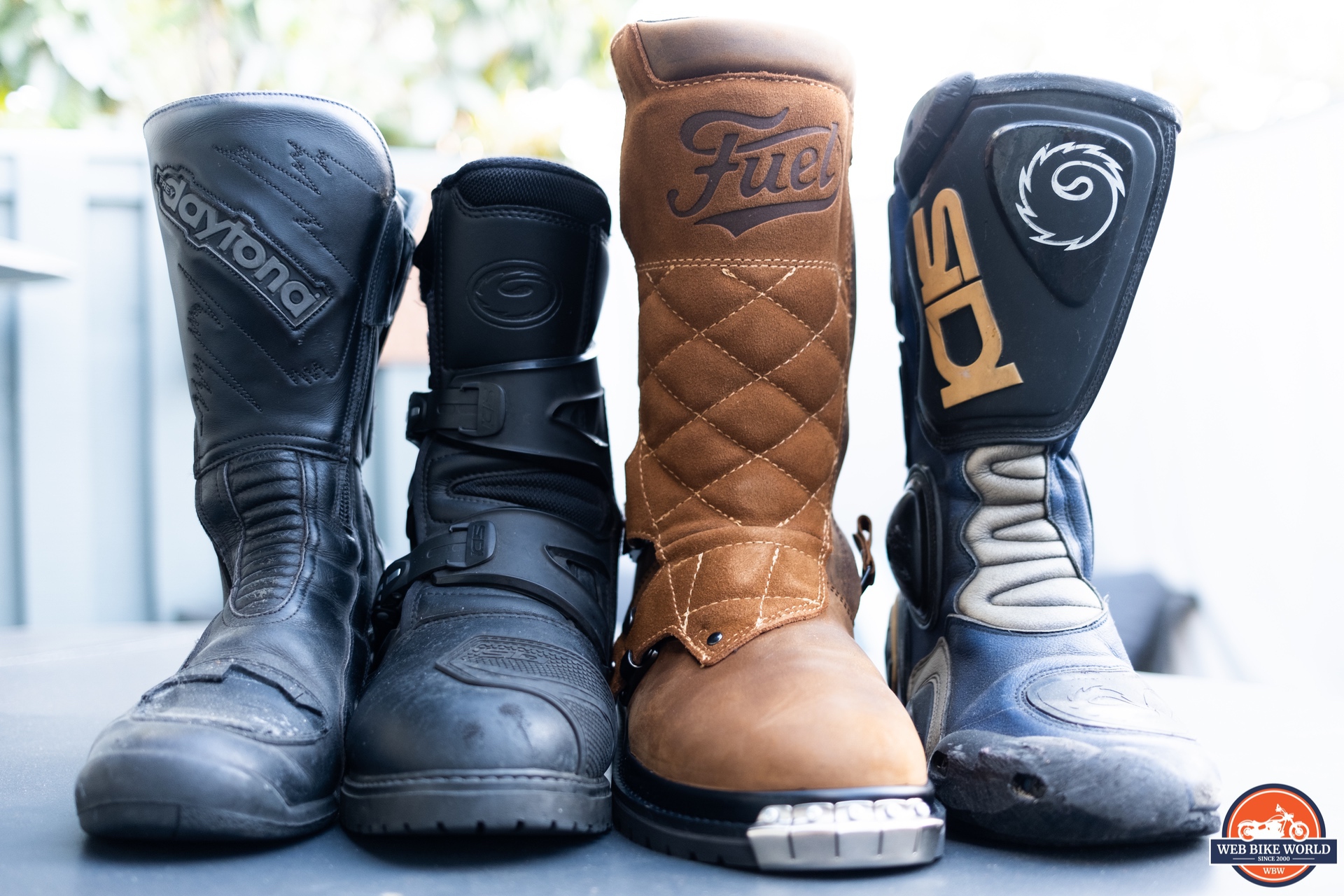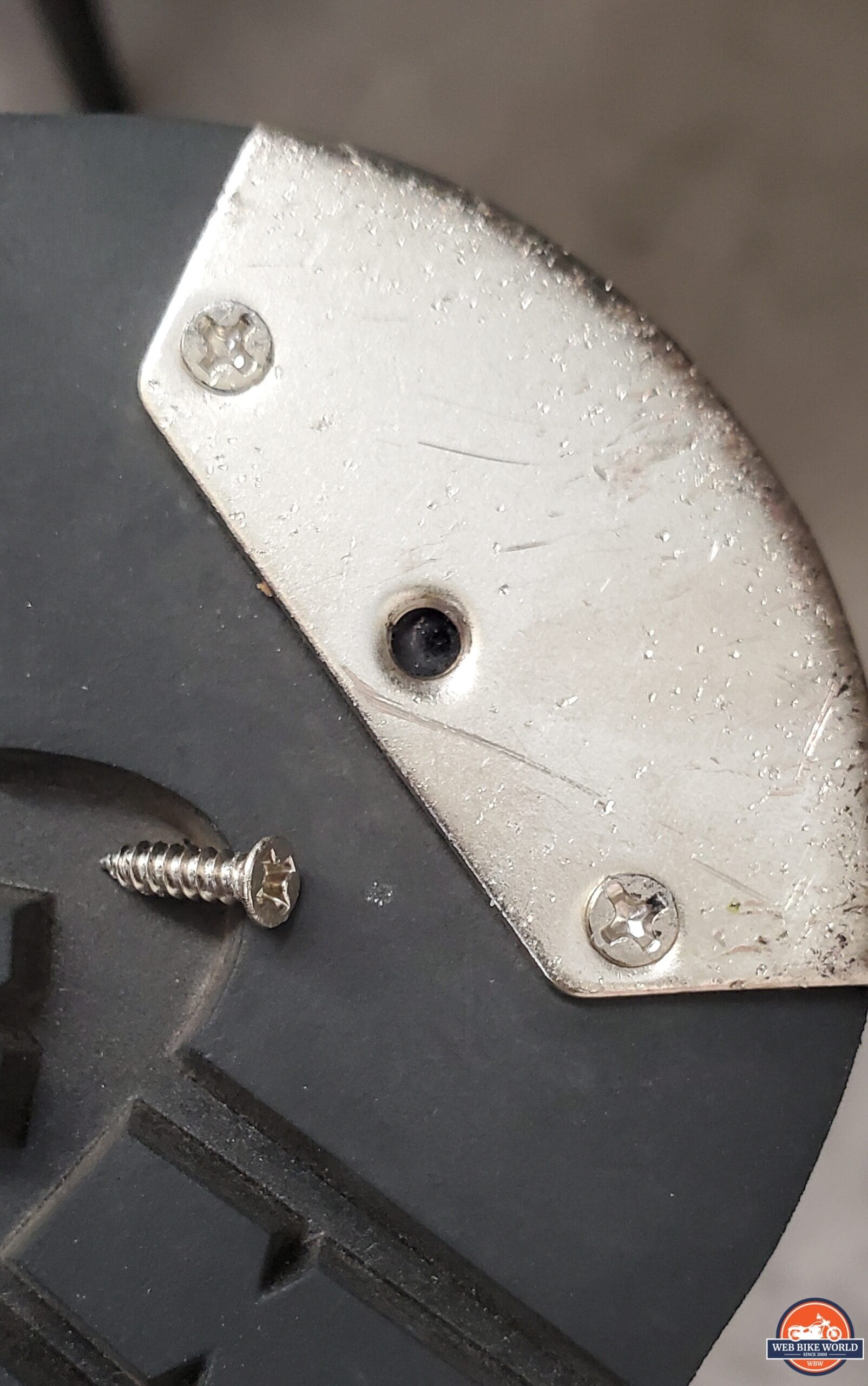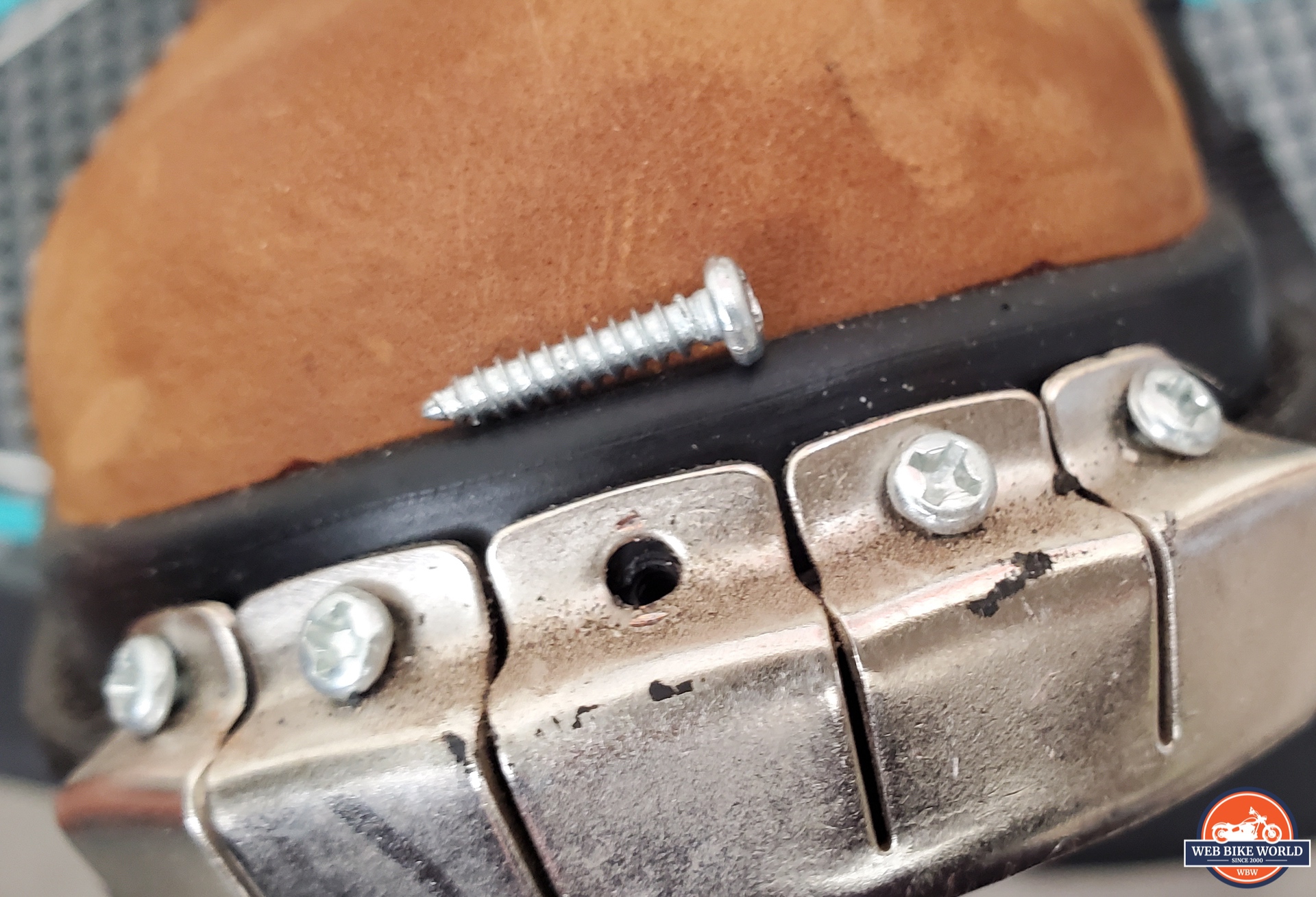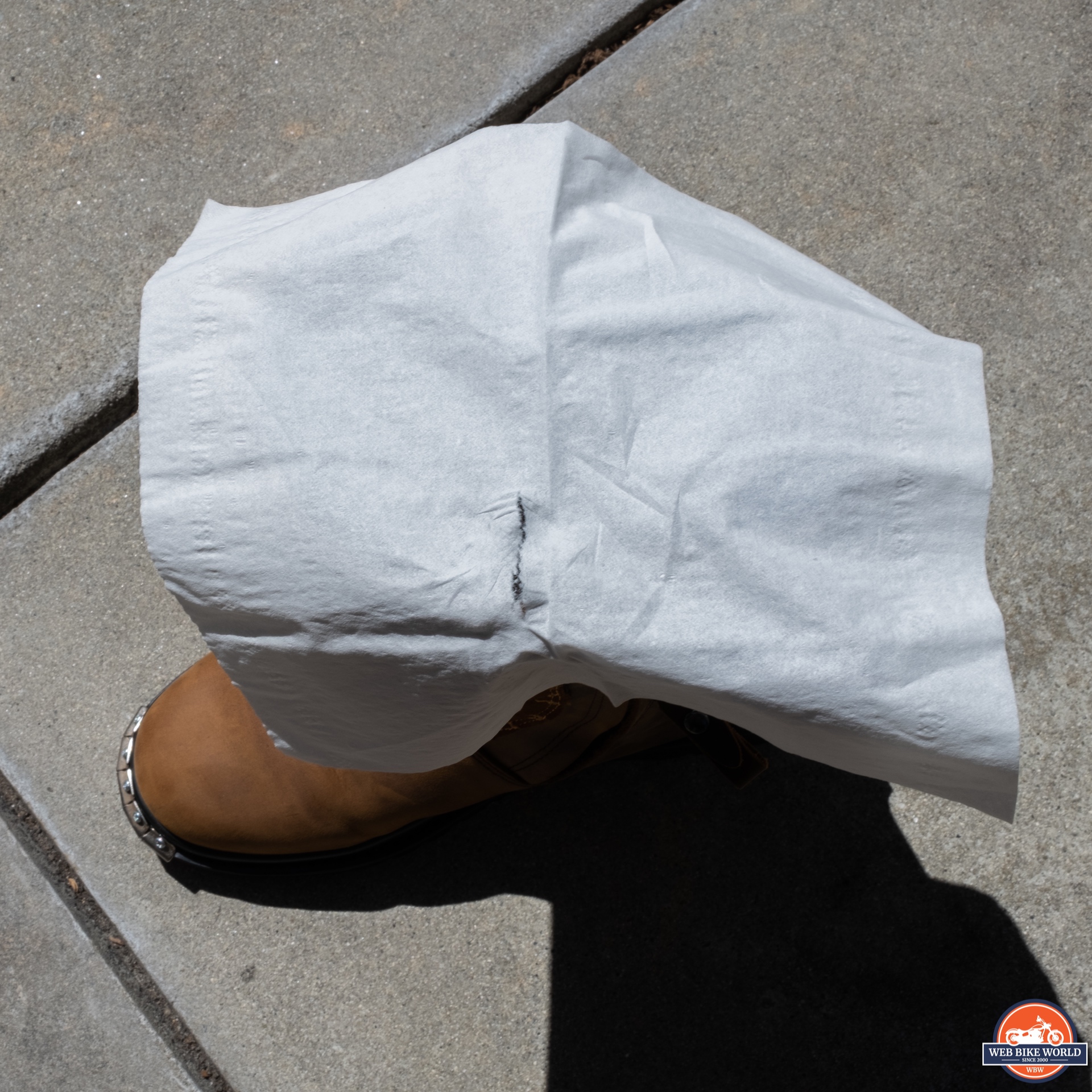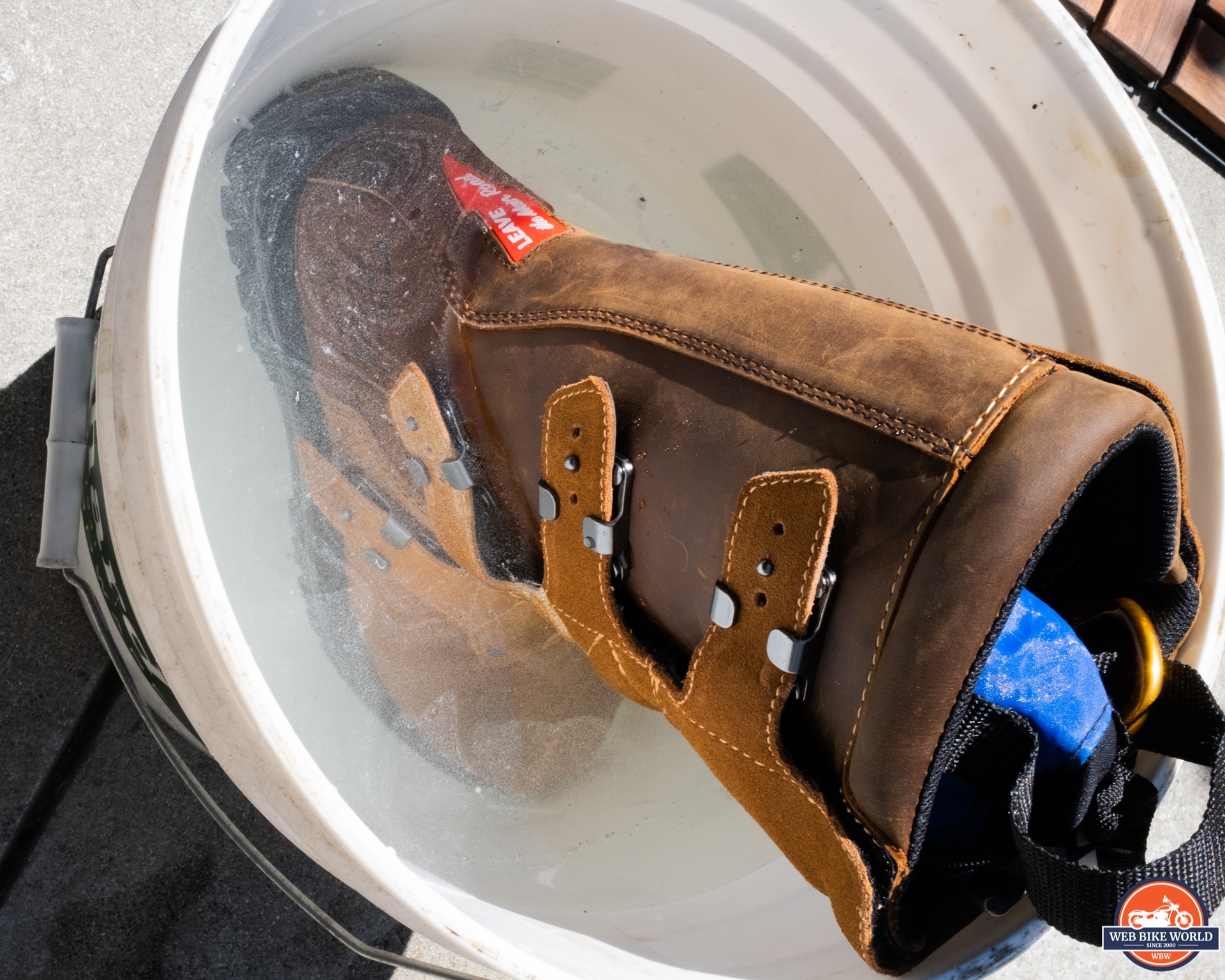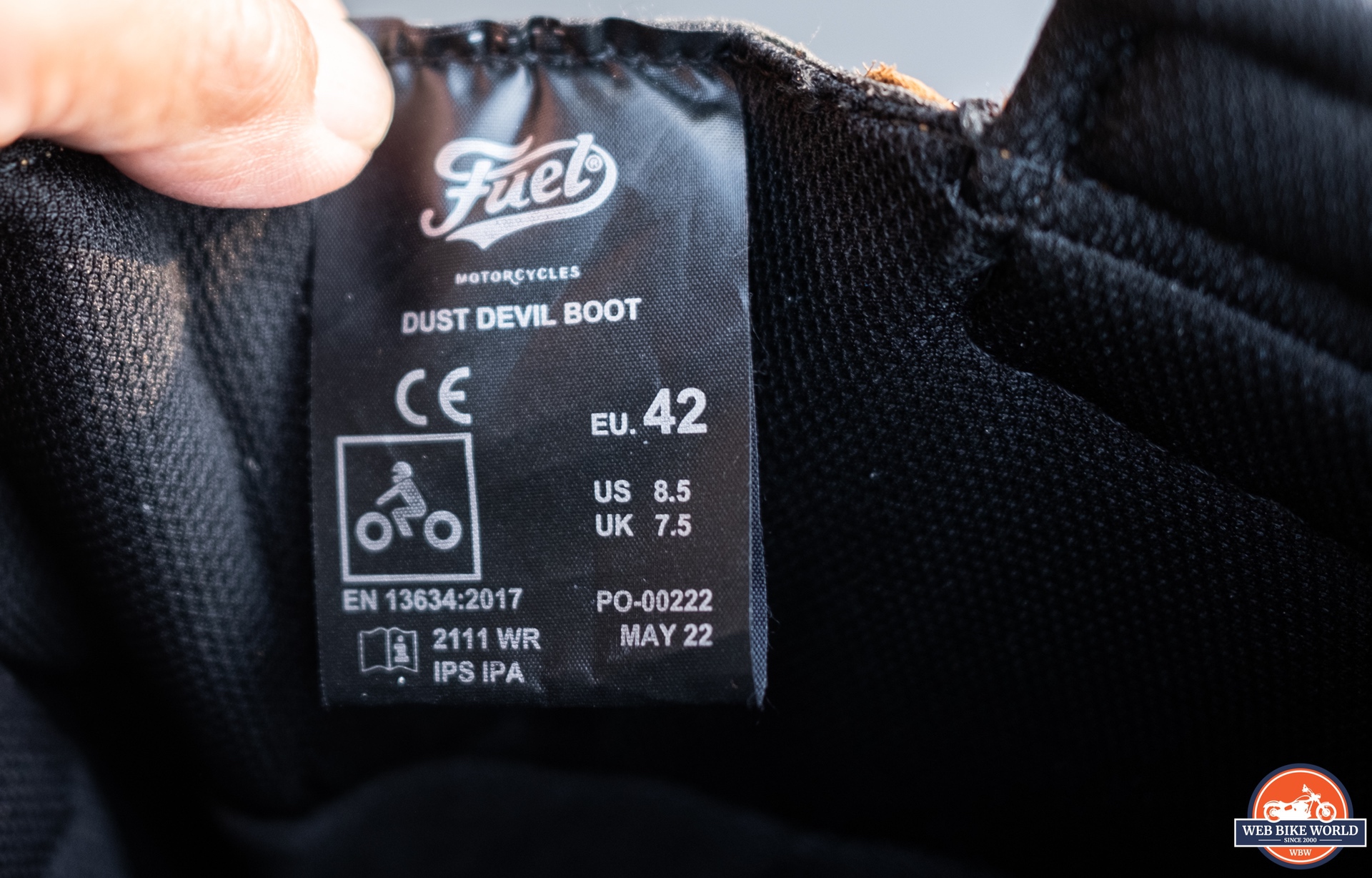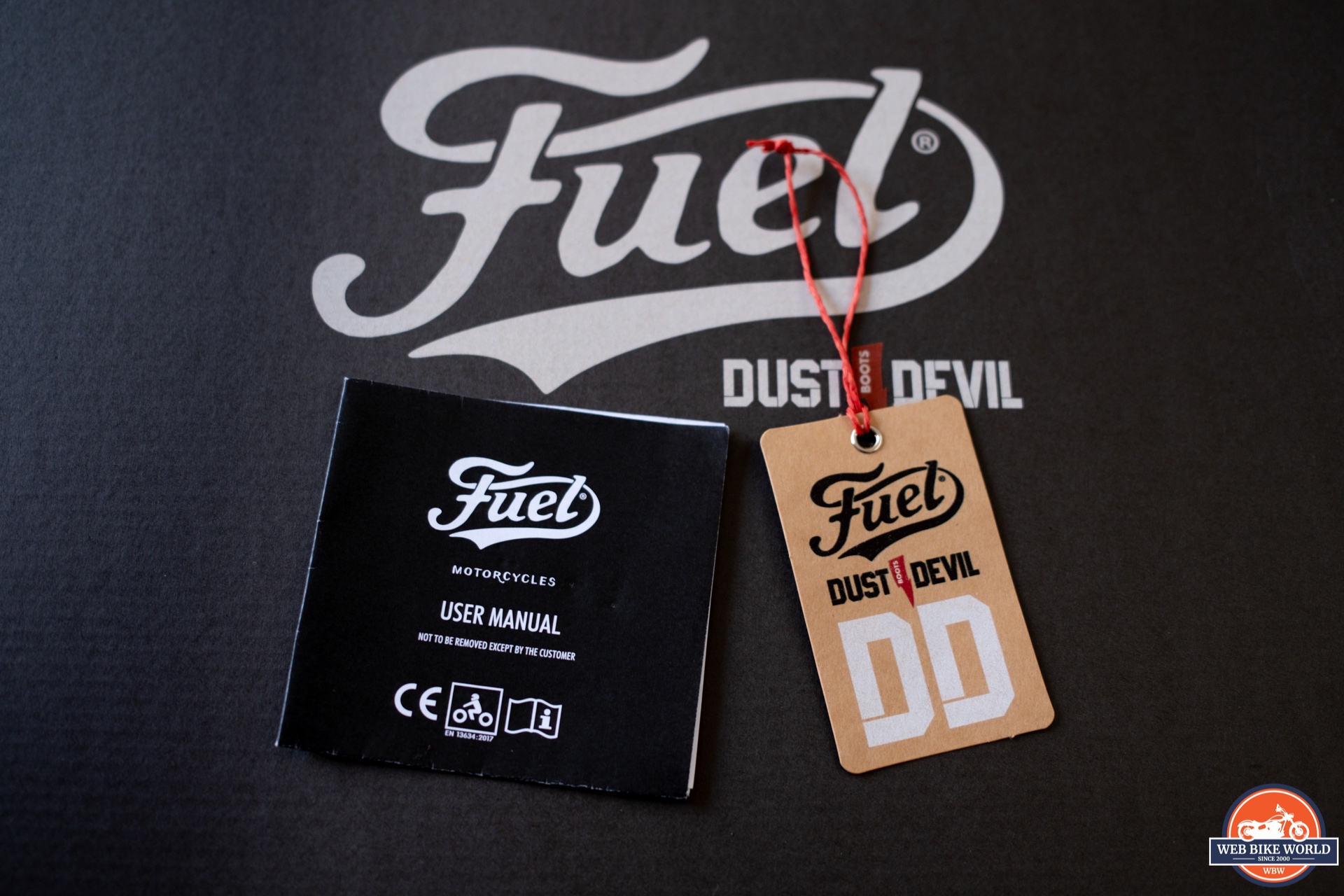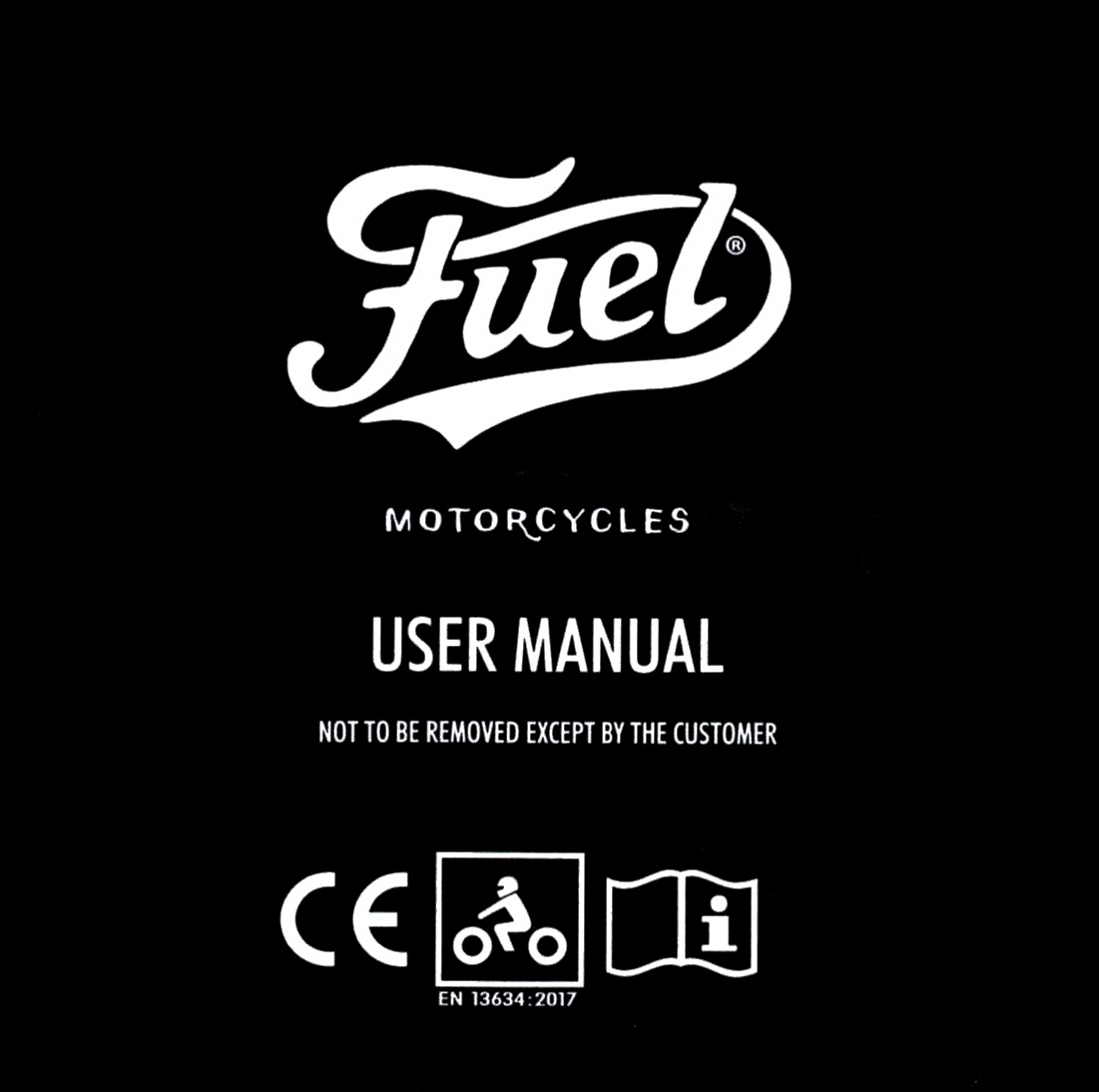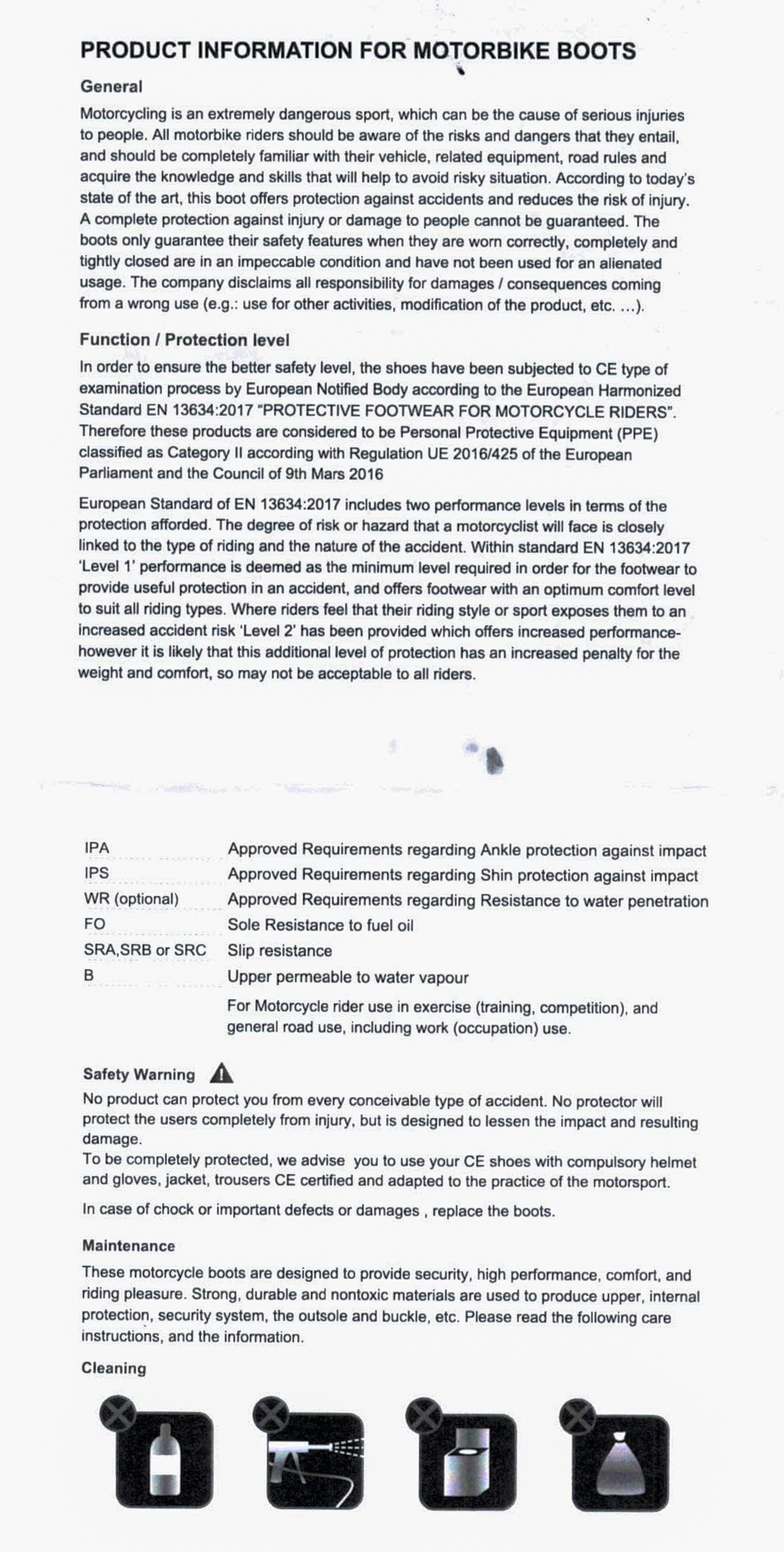admin
Staff member
Fuel Dust Devil Boots Real World Review Summary
Review Summary
The Fuel Dust Devil Boots have a unique, old-West inspired look—but make no mistake; these are modern-day boots for adventure riding and touring, with plenty of cutting-edge protective features. Not only do they look great and keep your feet safe, but they also hold up admirably under a wide range of riding conditions (especially for a boot made of leather). I have some minor issues with the sole and lack of a shifter pad, but these still come strongly recommended from me.
Aesthetics
Build Quality
Comfort & Fit
Protection
Water Protection
Pros
Does not look like all other boots
Waterproof
Highly protective
Adjustable side straps
Full leather
Comfortable (after a short break-in period)
Cons
Bonded sole rather than stitched
No shift pad on the left foot
4.5
Excellent!
Fuel Dust Devil Boots Real World Image Gallery
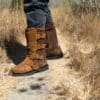
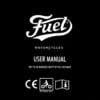

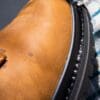
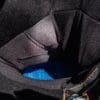
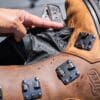

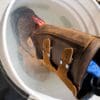

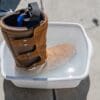
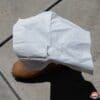
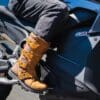
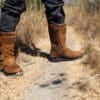
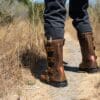


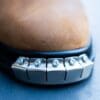
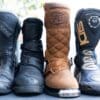
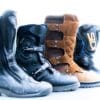
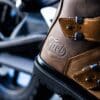
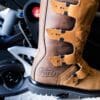
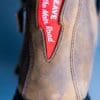
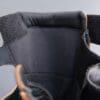
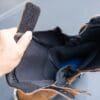
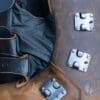
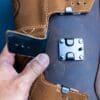
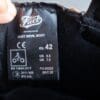
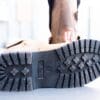
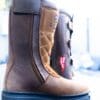
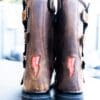
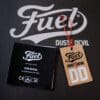
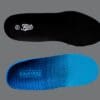
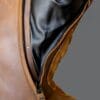
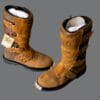
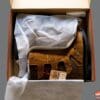
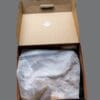
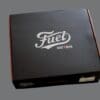
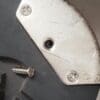
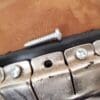
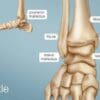
Buy Now
Fuel Motorcycles
I ride a dual sport motorcycle—a Zero DSR—and have been very happy with my current boots, the SIDI Adventure 2 Gore-Tex Mid Boots. During a recent off-road visit, I hit my shin just above where the mid-rise boots cover my leg. Nothing serious, but it did smart more than I’d like to admit. So I began to search for a full-length boot for those times when I know I’ll be riding off- and on-road.
The thing about a dual sport bike is that there are times when I think I’ll just be riding on the road, but then some off-road path appears and I just gotta try it. Exploring is one of my happy places.
I looked at the usual suspects: Alpinestars, Daytona, Sidi, etc. All are capable of offering protection, but I wanted something different. A bit out of the ordinary.
I cannot recall how I happened upon Fuel, but once I looked at the style and read the specs, I thought I’d take the plunge. The Dust Devil boots have not been out that long, but based on reading about some of their other gear, I was confident that they build quality apparel.
See Also: The Best Adventure & Touring Motorcycle Boots for 2022
In about a week, DHL delivered my boots, which I felt came quickly from Spain to California. And when I opened the outer shipping box, I was met with this:
I have recently reviewed the John Doe Defender Mono Cargo Trousers, which were also presented in a first-rate package, much like we expect from tech and luxury brands like Apple. I was hoping the boots would be as impressive as the package presentation. I felt like I bought boots from Nordstrom.
After removing the boots from the box, my cursory examination of the quality produced a smile.
Fuel’s website describes the brand’s history and mission as follows:
“A shared passion for motorcycles and vintage style brought Fuel’s creators together in 2012. We started building customized bikes in Barcelona and soon gained global notoriety in the scrambler and cafe racer scene. Our goal was to create a two-wheeled brand with authenticity at its heart. To make sure our bikes could survive tough terrains, we needed (and wanted) to ride them in extreme conditions! Fuel’s first Scram Africa—a 2,500km trip to the African desert—took place in 2013 and was a huge sand-soaked success. Today, it’s our landmark event for adventure junkies.
Fuel’s vision for a community of nostalgic riders evolved over the years. We started designing stylish riding gear that blends vintage looks from the past with all the innovations of modern technology. The high-quality retro clothing that we wanted to wear, but couldn’t find on the market. And now we’re the go-to place for old-school motorcycle apparel enthusiasts.”
Styling is a very subjective matter for any type of apparel. Boots are no exception, and perhaps this applies to them even more so in the very conservative world of motorcycling. As much as motorcyclists like to think of themselves as ‘rebels’ who pursue a dangerous activity, I’ve found most motorcyclists to be quite conservative with a tendency to keep with what has always been known or accepted. I chose these boots because they look out of the ordinary in today’s world of black high-tech boots with buckles and injected casings.
The boots harken back to an earlier era in terms of style. Fuel says:
“By spring of 1924, Camberley, Great Britain, was hosting the first-ever official scramble race. In this early era, riders rode motorcycles that were designed primarily for road rather than dirt use, racing across the rough, all-natural terrain of the English countryside at full speed.
“These brave pioneers paved the way for motocross as we know it today. With the “Dust Devil” boots, we want to be a tribute to that time, an exciting moment that would later lead to one of the most popular motorsports in the world. From this inspiration, the design process began.”
I like the styling of the boots (otherwise, I would have selected a different brand and style). The retro look is not compromised by a lack of included modern safety technology, either—these boots come with a CE Certificate EN 13634:2017 rating.
Fuel’s styling reminded me of my past motocross and desert racing in the late 1960 and early 1970s, while offering more of what I look for in today’s modern protection. A win/win for my money.
I’m not a huge fan of the red “Leave the Main Road” badge on the back of the boots, but since I ride a dual sport bike, I certainly appreciate the saying.
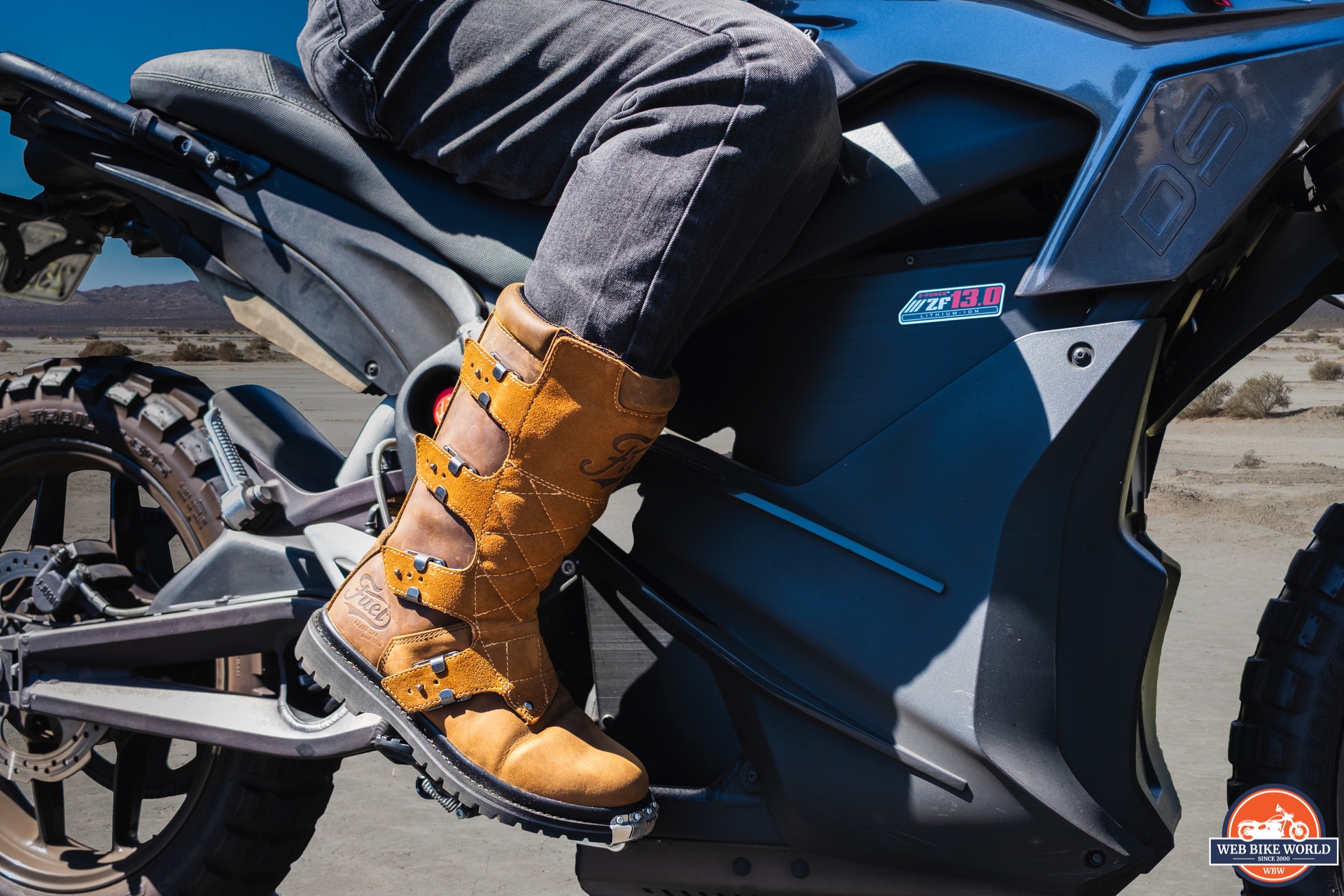
Fuel lists this for the Dust Devil’s build materials:
“Natural crazy horse leather construction with suede leather on the front. Crazy horse leather is made from full-grain cowhide: a coating of natural wax is applied to the leather that gets better and more beautiful with time and usage.”
I have never heard of the term “crazy horse leather” so after doing a bit of research, I found out how it derived its name:
“Crazy horse leather is full-grain leather that gets better and more beautiful with time and usage. Rather than wear out, a crazy horse leather develops a patina. The leather is made from an entire cowhide. Apart from the hair, nothing else is removed. You can easily tell the history of the cow from which the spots and marks on it make it.
Crazy horse leather is not from horse leather as the name might imply. It is called ‘crazy horse leather’ because it is used for horse saddles. The word ‘crazy’ signifies its toughness as it can hold a horse no matter how strong it is.”
Having worked with horses, specifically thoroughbreds, I can attest that the leather used on the boots does resemble the leather used for Western-style saddles.
The cowhide does display patina obtained from the cow even before age or wear. It is both rich in color and texture.
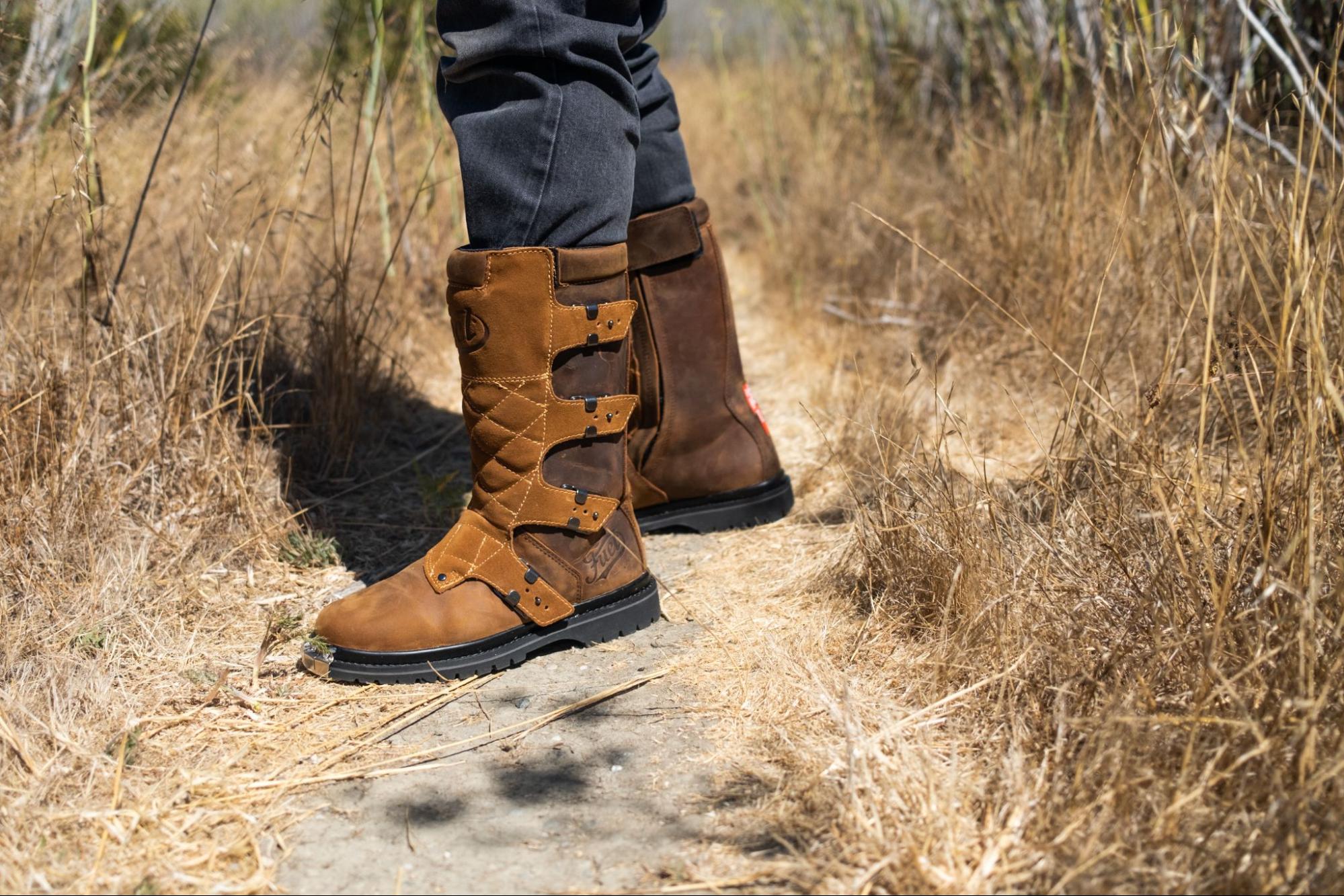
The suede tabs mate to what appear to be stainless steel slide buckles and are riveted into the sides of the boots. The rivets do not appear on the interior surface of the boot, and none of them can be felt while wearing them. Each tab has three adjustment holes to either loosen or tighten the boot against your foot and shin.
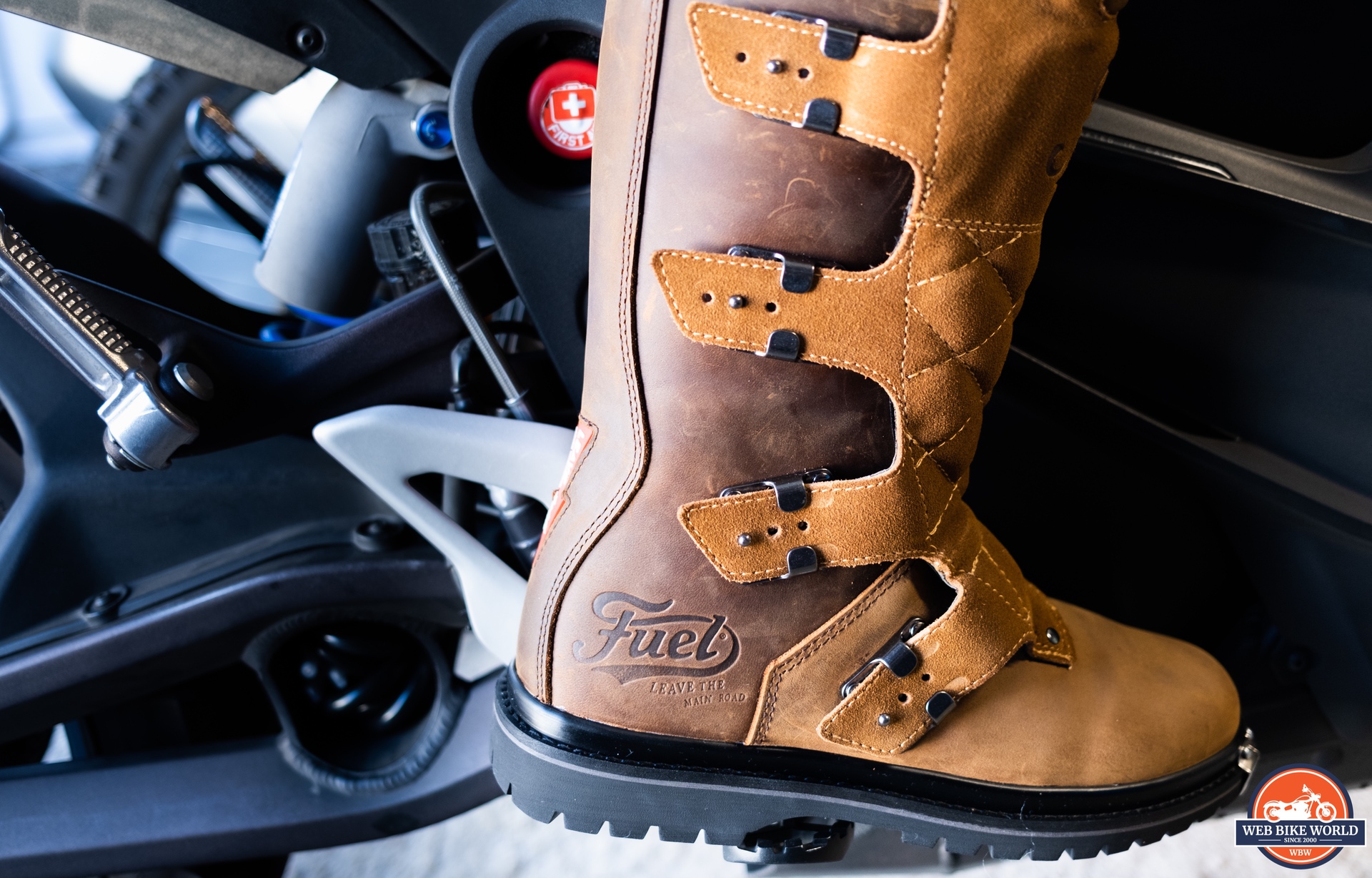
In the image above, you can see how I have adjusted the lower two tabs to their full extension. I prefer the fit of the boot in this arrangement. Even though there are only three adjustment levels for each tab, I found that to be plenty. As time goes on and the boots break in even more, I may adjust the tabs further.
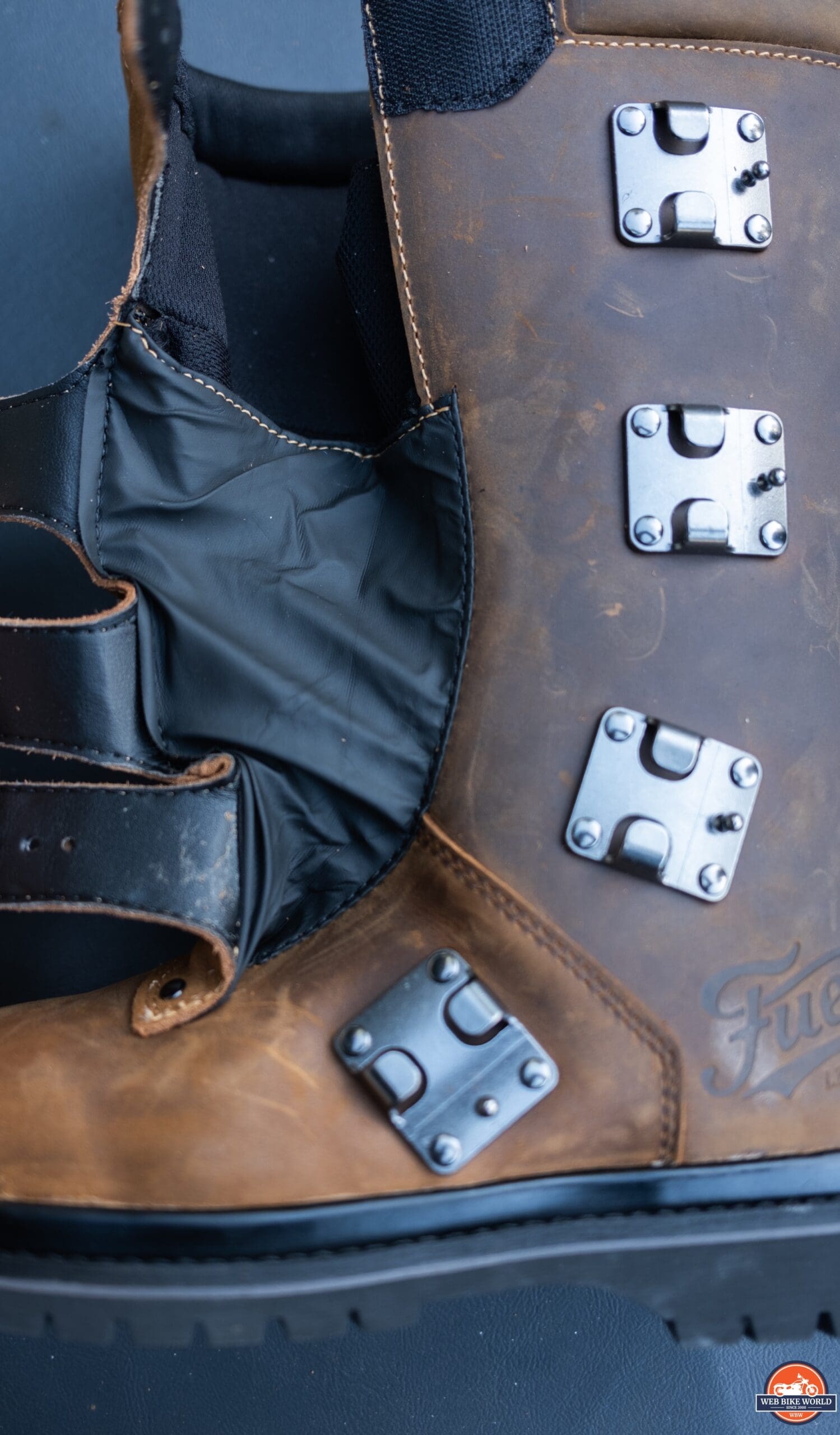
The precision and quality of the stitching are also apparent in this photo. This stitching quality is apparent throughout the boot. No stray threads or sloppy stitching; very impressive and reminiscent of my older Vanson leathers.
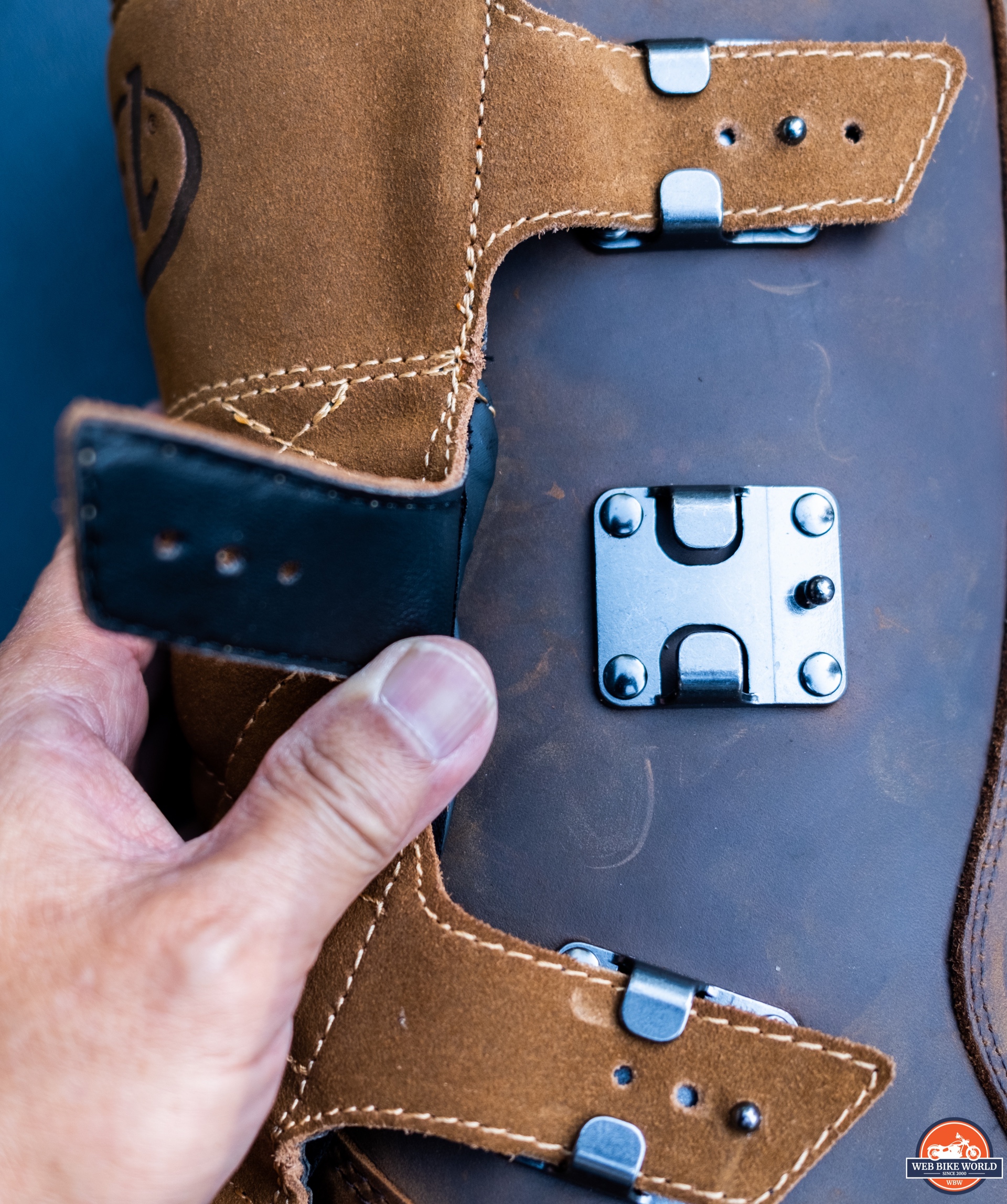
Entry into the boot is accompanied by a zipper located on the inside portion of the boot. At the top of the zipper is a large velcro flap that covers the zipper’s top. The zipper has a small leather pull.
If the zipper went down about a half inch more, it would make removing the boot much easier. Perhaps it will become easier to remove the boots after more time, but entry is fine.
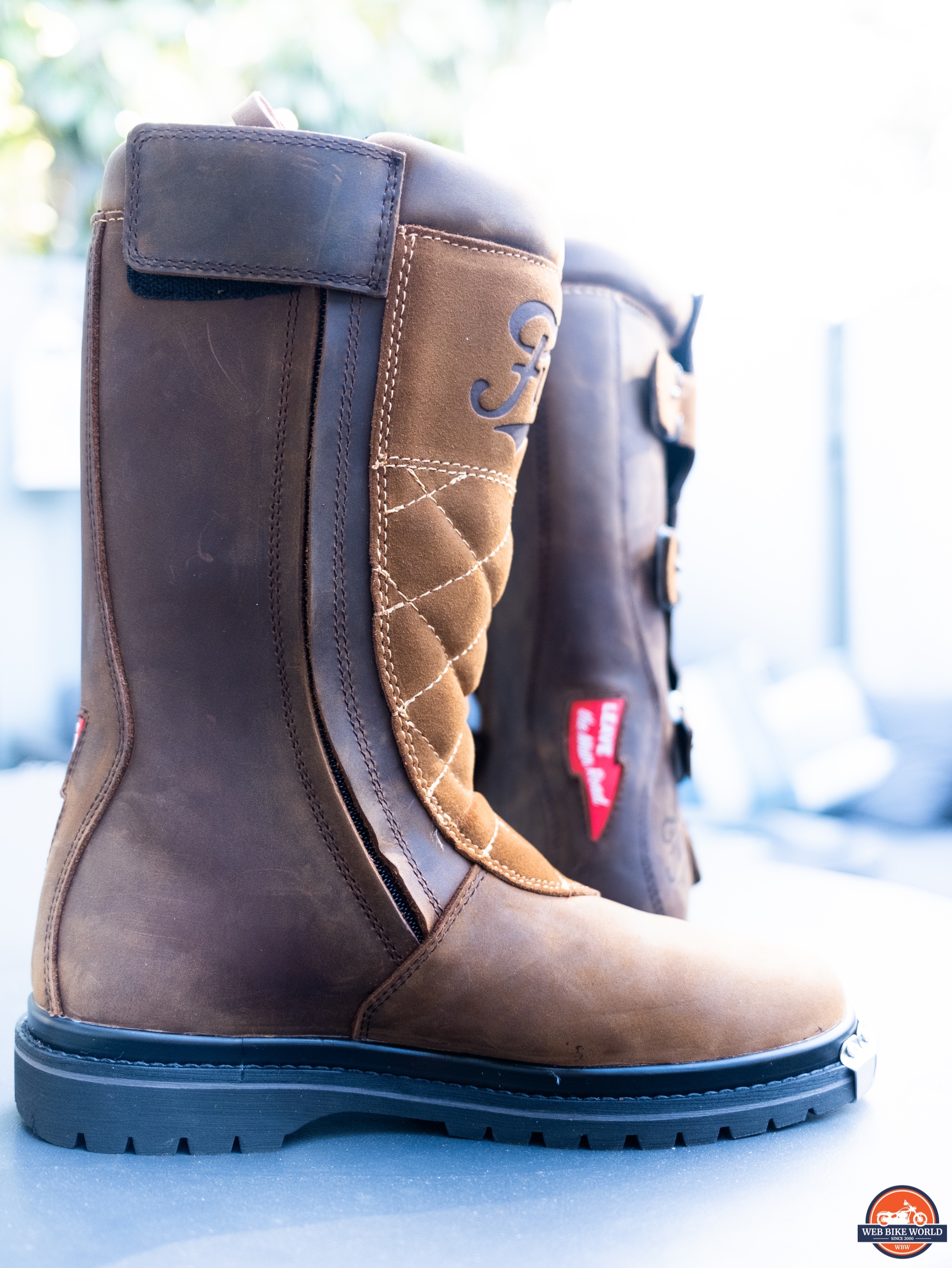
The boots have a waterproof membrane that encases the footbed as well as the upper portion of the boot. The waterproof membrane extends up to the second from the top buckle. Beyond that, I believe the boot would let water into the interior. The stitching is flawless.
The soles of the boots are classic military/police/construction tread patterns. They are very thick, but the one thing that I’m disappointed with is that the soles are bonded and not sewn. The stitch lines around the soles are strictly decorative, not functional. So if I wear out the soles I would need to determine if a cobbler can repair/replace the bonded sole.
The top of the boot has two velcro attachments. One is located at the top of the entry zipper. The other is on the inside of the top of the boot. In addition to the suede buckles that adjust the closure, the two velcro tabs can loosen or tighten the fit at the top of the boot.
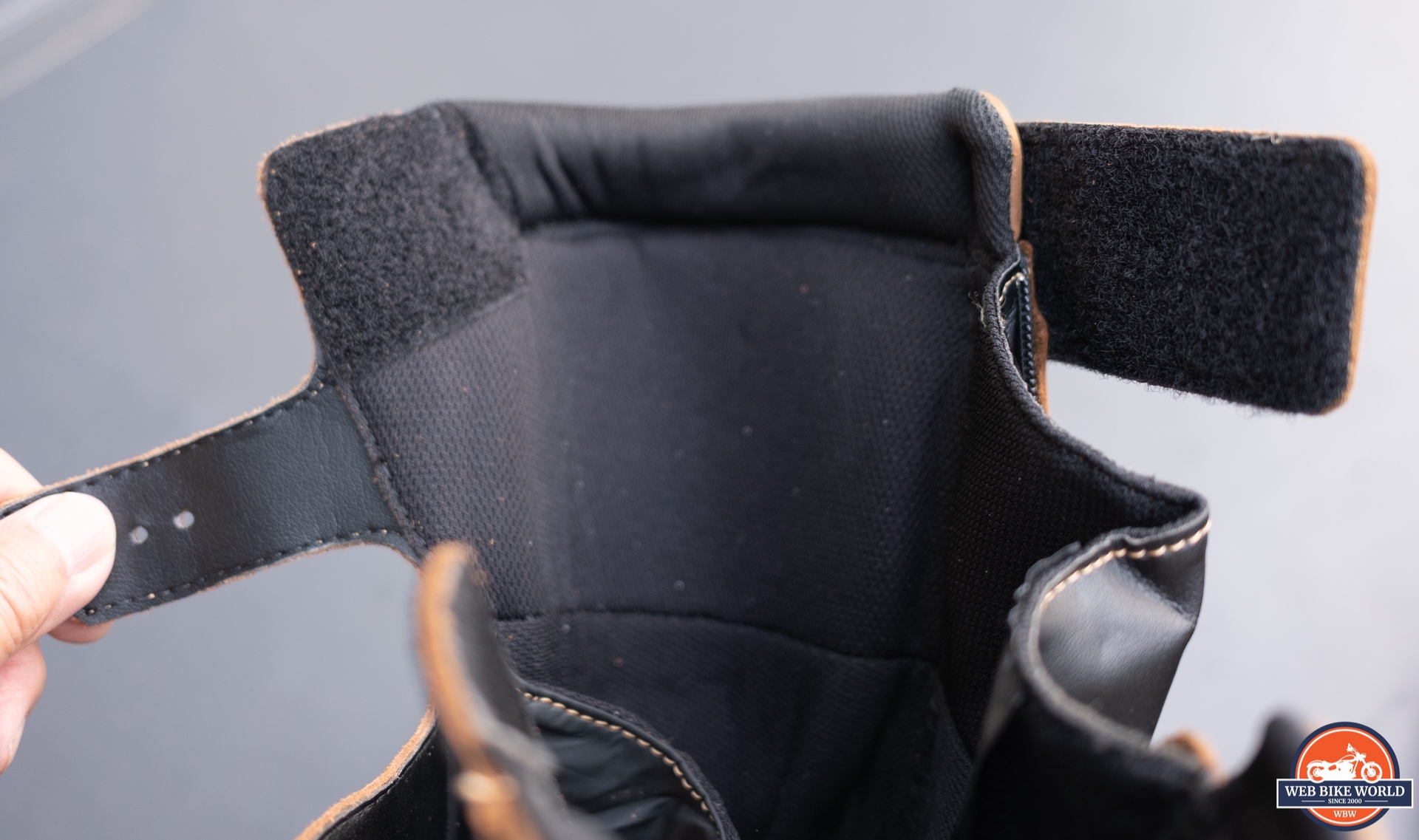
In the image below, the velcro tab at the top of the image is the one that secures the zippered side of the boot. Directly opposite is the second velcro tab, which can be adjusted for upper calf tension.
One feature that is common on motorcycle boots is shift reinforcements on the left and/or right upper portion of the boot. The Fuel boots do not have these, and I suspect it was a decision made for aesthetic reasons.
Because I ride an electric Zero DSR with direct drive, it doesn’t have a transmission—so no shift lever. But it is something to consider if you ride a smoker bike. Personally, I will enjoy watching the leather develop over time with nicks, scrapes, and dirt.
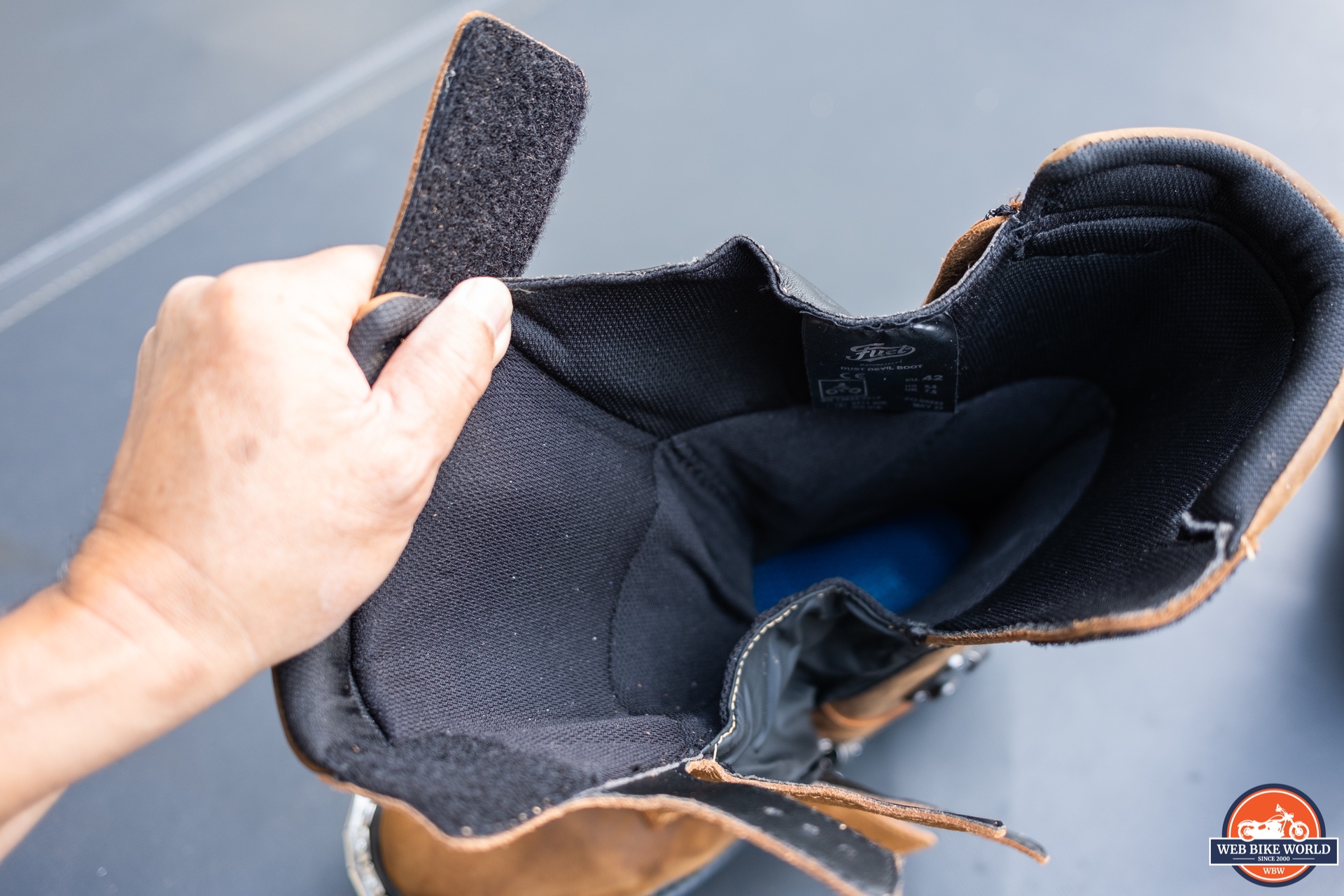
I want to mention that unless I test protection myself firsthand, I compare what I purchase to equipment that I have unintentionally crash-tested at the racetrack. Those crashes were all above 90 MPH.
I cannot even begin to count the number of times I’ve crashed in the dirt or desert. And back then, my protection of choice was riding jerseys, army/navy surplus boots, and jeans.
Because I can examine the resulting damage to my gear post-accident, I can assess areas where the clothing failed or survived. I have raced and crashed in Sidi full-length racing boots and never suffered any damage to my ankles, ankle bones, or feet.
See Also: The Best Motorcycle Sport Boots in 2022
In total, I own four sets of motorcycle boots: two Sidis (one full length, one mid-rise), one pair of Dayton’s, and now one pair of Fuel Dust Devils.
I have low-sided twice and high-sided once in my racing Sidis. Those boots have 23,000 track miles on them. The low sides were at 91 and 104 MPH, and the high side was at 140.
Because of those experiences (and my lack of any lower body injuries), I’m confident about what to look for in a boot. I realize that riding off-road is different from road racing, but I feel the Fuel Dust Devils will protect my feet and ankles.
The most vulnerable bones for the feet are:
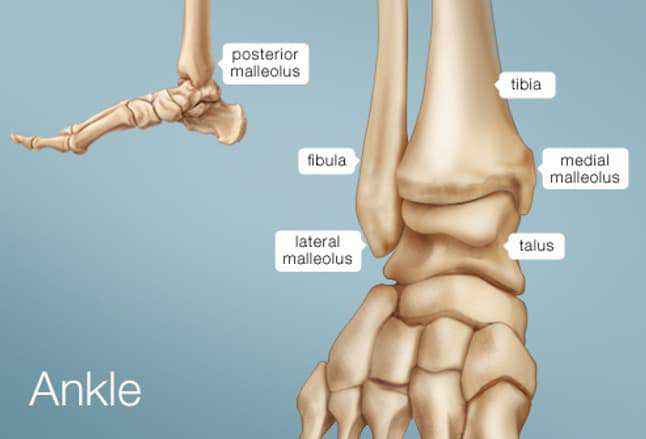
The specific reason I’m sensitive to those bones is not that I’ve injured myself in those areas. When I first started street riding, one of the men in our group wore those lower-cut ‘motorcycle shoes’ I see so often. He entered a mountain corner too hot while on the right side of the road. Had he drifted further right he would have fallen down a 200-foot cliff. He panicked and chopped the throttle, causing a low side.
The accident resulted in his left ankle bone the Medial Malleolus being ground flat. His motorcycle shoes did have protection around those bones, but because they are so soft and low in height, the shoes slid down, exposing his bones. Man, was he in pain—long after the paramedics did what they could while transporting him.
At the track, we always wore race boots—full boots, since they, of course, are required. And those boots always had protection in the heel, the ankle, and the toes. A strong shank ran the entire length of the sole.
The Dust Devils contain shin protection, but do not have a steel footbed shank. I tried my best to get a shot of the ankle disk inside of the boot, but alas, I gave up. It’s there; I just could not photograph it.
Fuel also provides metal toe skids on each boot. I have no experience with those, but they are securely attached to each sole with self-tapping screws. I remember flat trackers used to wear boots that had these metal toe sliders. My impression is the metal toe guards are more decorative than functional.
The self-tapping screws on the bottom are not as well threaded into the sole as the top screws, and I will not be surprised if they work their way out over time. The screws on the front of the toe tap well into the sole of the shoe.
I chuckle a bit when I walk on concrete or a hard surface. The metal toe guards act a bit like tap shoes, making that distinctive clicking sound when I walk. It makes me wanna dance, and I may remove the metal guards at some point.
Since the boots are saddle quality leather and feel like saddle leather, they are not slipper comfortable when first worn. Nope, they are much like leather cowboy boots—meaning it takes some time to break them in.
I found that wearing them while walking helps them conform to my feet. I’m also flat-footed, so I had ordered some over-the-counter orthotics to place inside the boots to replace the Fuel liners. It made my feet very happy.
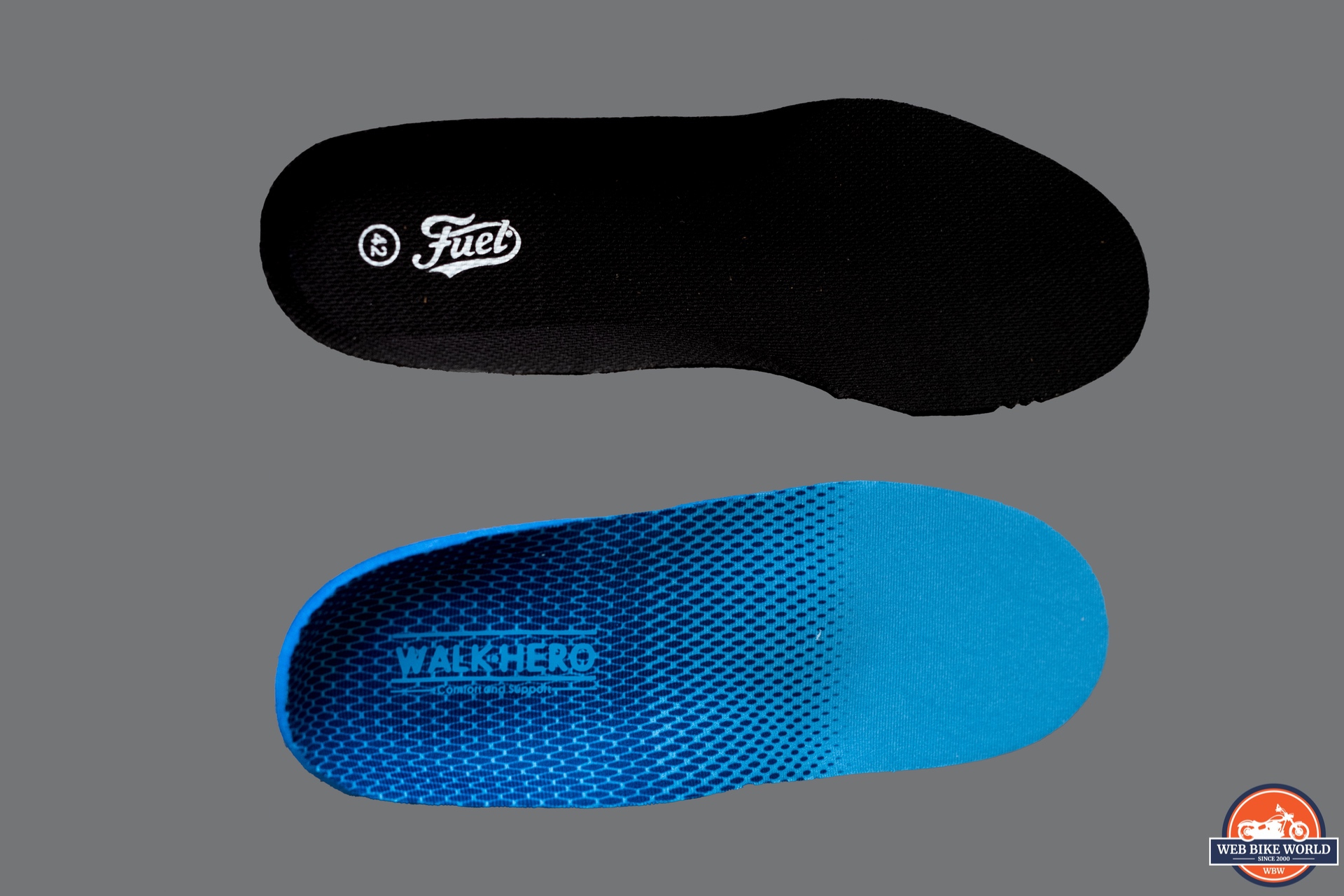
I wear a size 8.5 in USA sizes, which is a size 42 in EU measurement. I had clicked the wrong button when ordering mine, and wrote to Fuel after discovering my mistake. They wrote back to me the next day stating they would correct my error. I was relieved to see that the 42s arrived at my doorstep.
The boots feel very good, but I bet they will feel great in another month of riding and walking. I do NOT think they are as comfortable as my Sidi mid-rise boots for walking. Those felt like slippers when I first slipped them on. But they are not full-length boots.
I have this little thing I do when I get new shoes or boots. I walk around in them without socks. I have personally found that doing so reveals potential irritation points that are otherwise masked by wearing socks.
I noticed that the right boot’s outside ankle protection initially irritated my outside ankle bone. After walking in the boots for a week, the irritation disappeared. And as the boots began to break in, their comfort increased dramatically.
Are they 5 miles walk-around boots? Nope. But neither were my Sidi race boots. They are certainly much more comfortable than those ever were, that’s for sure. On a trip, could I wear them to walk to dinner? Yep. Can I tap dance in them? Yep, just not enough that people would stop laughing at the fool in the biker boots.
Unlike street riding, venturing off-road often means I’m standing. My posture and leg position while standing are very different from just sitting—or, in the case of sport bike riders, being in a tuck.
The boots are very comfortable whether I’m in a standing or sitting position—no binding of the pant leg or odd shifting of my foot in the boot. How the boot reacts to your pants being tucked into them will depend largely on the type of pants you’re wearing. My tapered pants work just fine in the boots. Chafing of my shin is not an issue when my pants are worn outside of the boots.
I immersed the boot (just one) into a bucket of water for 15 minutes. After examining the inside of the boot, I saw that the waterproof membrane extends to the second from the top buckle. The membrane on the zipper side of the boot goes all the way to the top, but on the opposite side, only to the second buckle.
I have found that when I test for water using a single Kleenex tissue, it reveals water intrusion more accurately than just feeling by hand or foot. I placed the tissue on the footbed. The blue thing in the following photos is the little sandbag I used to weigh down the boot to keep it submerged in the bucket.
For those nitpickers, I photographed my phone after I started the timer:

After 15 minutes, I removed the tissue and was pleased to see it was bone dry.
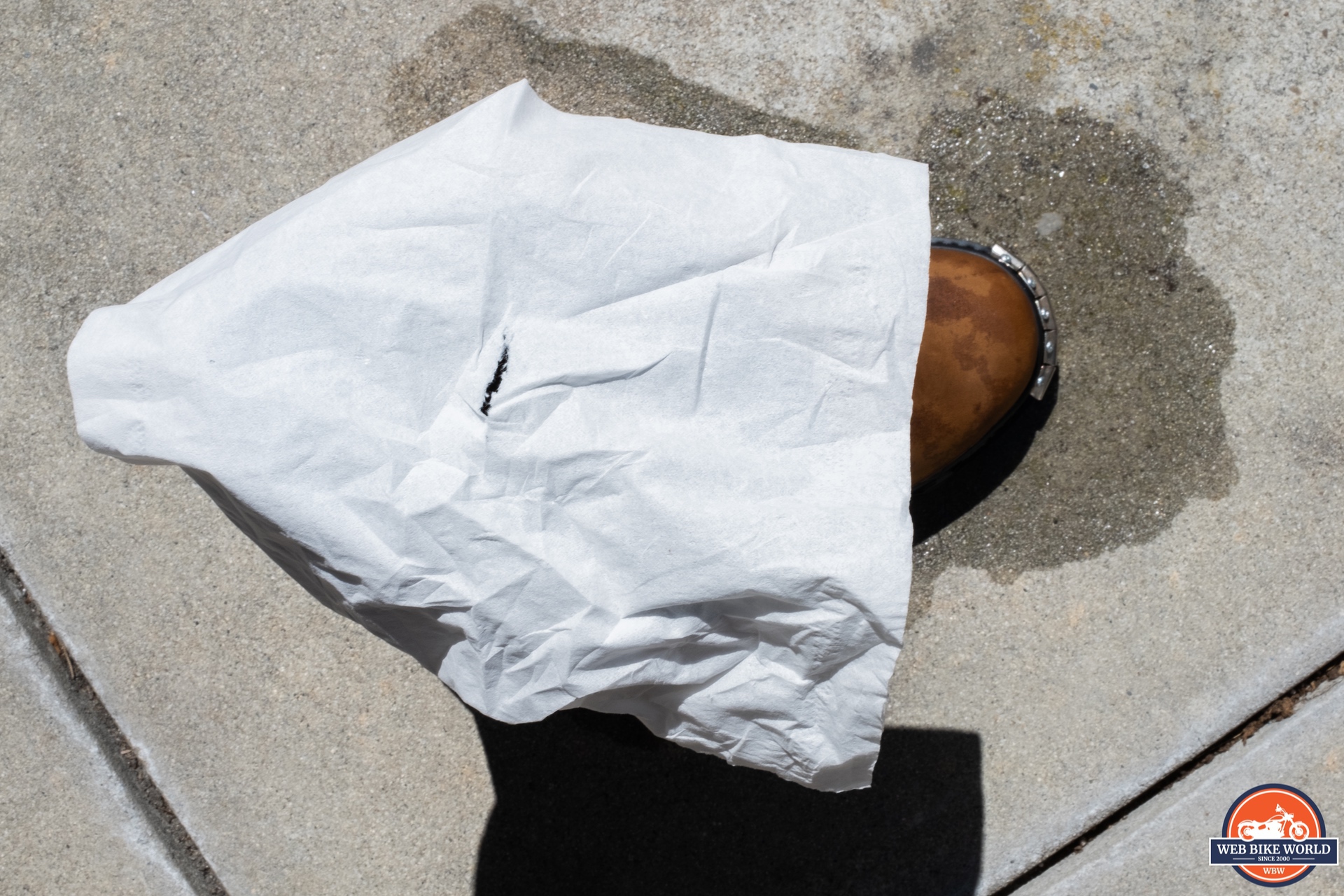
The only portion of the boot that felt moist was the upper inner portion of the calf area. I have highlighted the area to illustrate where I felt the moisture. It was not quite damp, but not bone dry like the other portions of the boot’s interior.
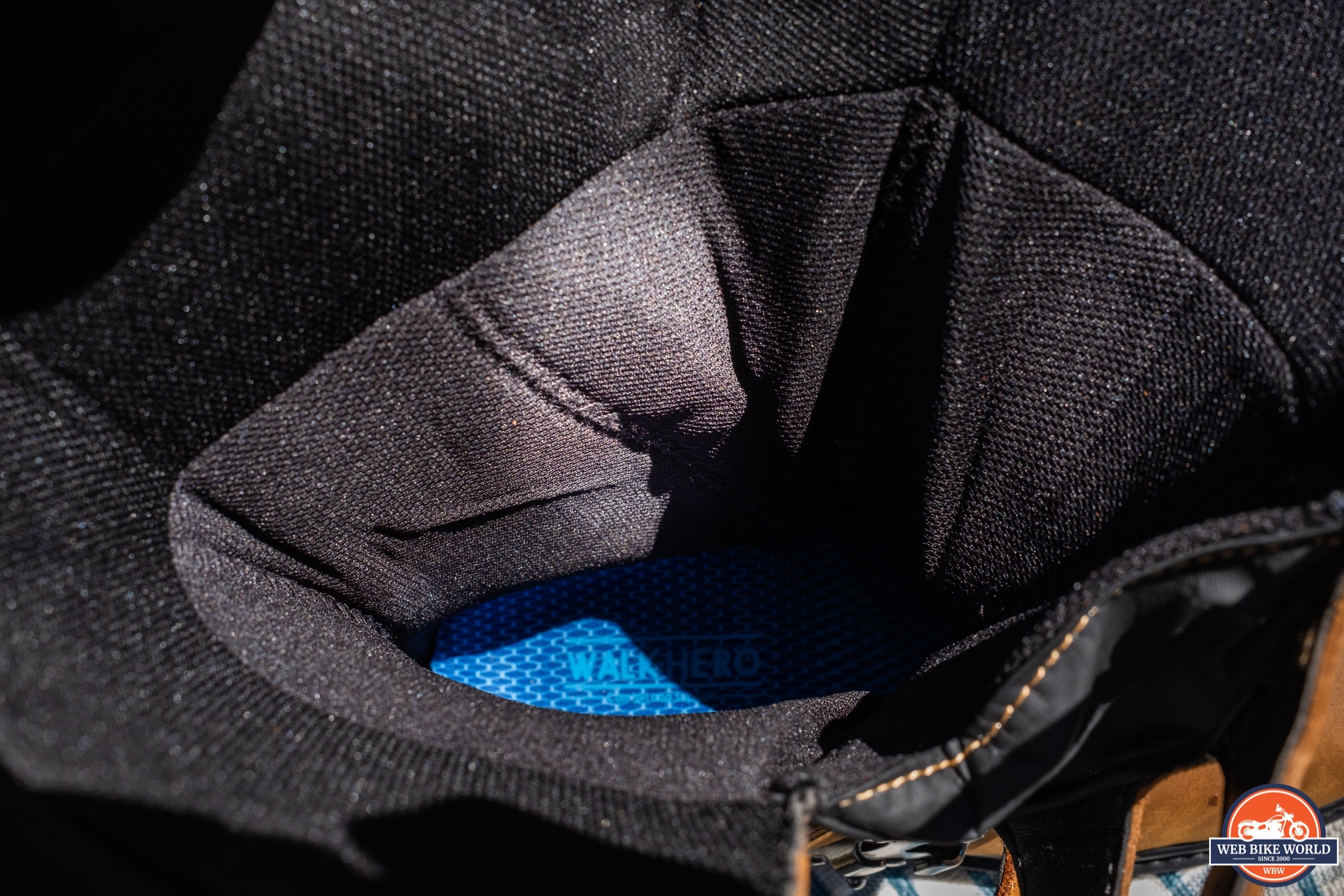
This image shows the exterior facing membrane and the water underneath the suede shin protection. No moisture was felt in this area.
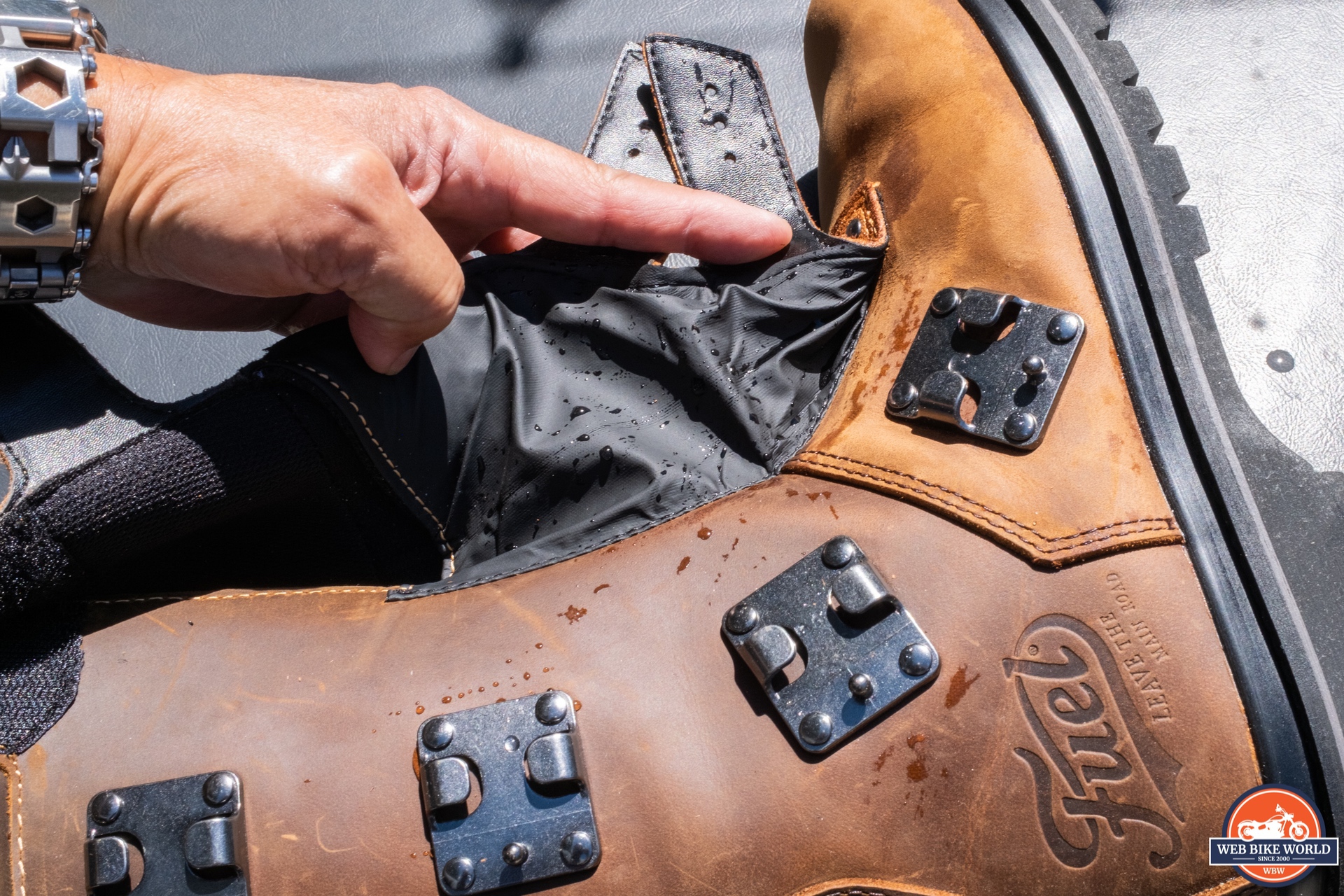
I realize that some individuals bucket test boots in ice water. I opted out of that facet for two reasons. First, ice water constricts the pores of most materials, which may add to the perceived waterproofness of the item. Next, if a boot keeps my feet that warm in snow or ice, I believe it will be too hot in warm weather.
When I ride in very cold weather, I’ll wear thermal socks. “The right tool for the right job” is one of my favorite mottos.
One of the things I wanted to note is that after doing my bucket dunk test, the exterior area between the footbed and the sole continued to weep moisture for several hours. I will surmise that the water that seeped in between the bonded sole and the footbed was the source of the oozing moisture.
It never entered the interior, but it is something to note. I do know that using any type of heat to dry leather is never advisable, so simply letting the boots air dry is recommended.
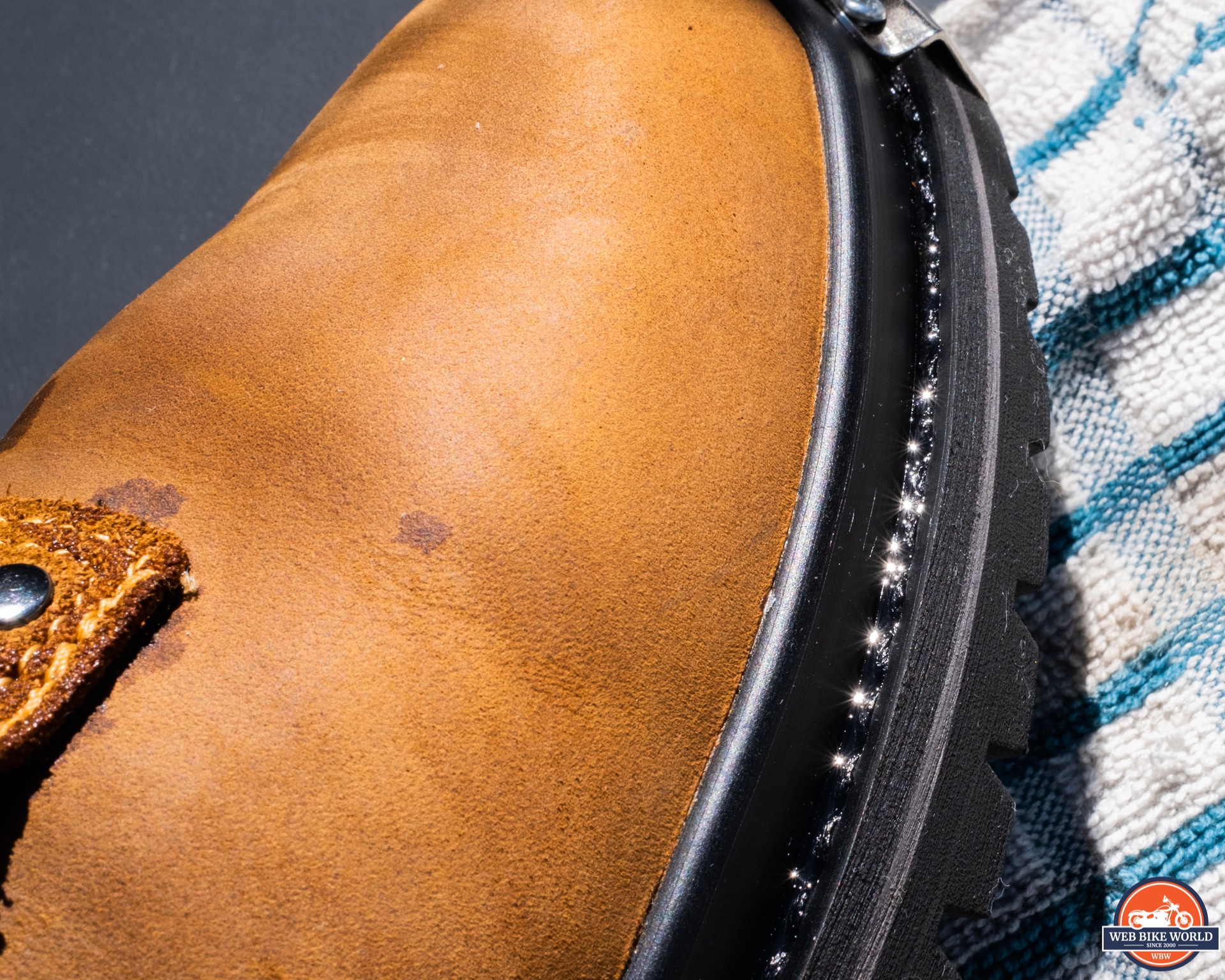
After my little water test, I’m confident that during the type of riding I do (in the rain or through a stream crossing), the Dust Devils will keep my feet dry.
At three hundred and fifteen bucks, the Fuels mid-pack in terms of price for dual sport full boots. Not as cheap as some, not as expensive as others. For me, they offer good value since they’re well made, comfortable for a full-length boot, and don’t look like every other boot on the planet.
The Fuel Dust Devil boots are what I consider to be handsome, protective, and of good value. Are they for everyone? Of course not, since some can find fault with a wet dream. I happen to like the looks of the boots, and the protection level/execution seems to be of high quality from my experience crashing at the racetrack.
While they are in the mid-pack from a pricing standpoint, you get a lot for your money here. Will they elevate me from a mid-pack dual sport rider to a world-class one? Nope, but my feet will feel safe trying to get there.
The post Fuel Dust Devil Boots Real World Review appeared first on webBikeWorld.
Continue reading...
Review Summary
The Fuel Dust Devil Boots have a unique, old-West inspired look—but make no mistake; these are modern-day boots for adventure riding and touring, with plenty of cutting-edge protective features. Not only do they look great and keep your feet safe, but they also hold up admirably under a wide range of riding conditions (especially for a boot made of leather). I have some minor issues with the sole and lack of a shifter pad, but these still come strongly recommended from me.
Aesthetics
Build Quality
Comfort & Fit
Protection
Water Protection
Pros
Does not look like all other boots
Waterproof
Highly protective
Adjustable side straps
Full leather
Comfortable (after a short break-in period)
Cons
Bonded sole rather than stitched
No shift pad on the left foot
4.5
Excellent!
Fuel Dust Devil Boots Real World Image Gallery








































Buy Now
Fuel Motorcycles
The Fuel Dust Devil Boots: Tough, Sturdy, & Striking
I ride a dual sport motorcycle—a Zero DSR—and have been very happy with my current boots, the SIDI Adventure 2 Gore-Tex Mid Boots. During a recent off-road visit, I hit my shin just above where the mid-rise boots cover my leg. Nothing serious, but it did smart more than I’d like to admit. So I began to search for a full-length boot for those times when I know I’ll be riding off- and on-road.
The thing about a dual sport bike is that there are times when I think I’ll just be riding on the road, but then some off-road path appears and I just gotta try it. Exploring is one of my happy places.
I looked at the usual suspects: Alpinestars, Daytona, Sidi, etc. All are capable of offering protection, but I wanted something different. A bit out of the ordinary.
I cannot recall how I happened upon Fuel, but once I looked at the style and read the specs, I thought I’d take the plunge. The Dust Devil boots have not been out that long, but based on reading about some of their other gear, I was confident that they build quality apparel.
See Also: The Best Adventure & Touring Motorcycle Boots for 2022
In about a week, DHL delivered my boots, which I felt came quickly from Spain to California. And when I opened the outer shipping box, I was met with this:
I have recently reviewed the John Doe Defender Mono Cargo Trousers, which were also presented in a first-rate package, much like we expect from tech and luxury brands like Apple. I was hoping the boots would be as impressive as the package presentation. I felt like I bought boots from Nordstrom.
After removing the boots from the box, my cursory examination of the quality produced a smile.
About Fuel Motorcycles
Fuel’s website describes the brand’s history and mission as follows:
“A shared passion for motorcycles and vintage style brought Fuel’s creators together in 2012. We started building customized bikes in Barcelona and soon gained global notoriety in the scrambler and cafe racer scene. Our goal was to create a two-wheeled brand with authenticity at its heart. To make sure our bikes could survive tough terrains, we needed (and wanted) to ride them in extreme conditions! Fuel’s first Scram Africa—a 2,500km trip to the African desert—took place in 2013 and was a huge sand-soaked success. Today, it’s our landmark event for adventure junkies.
Fuel’s vision for a community of nostalgic riders evolved over the years. We started designing stylish riding gear that blends vintage looks from the past with all the innovations of modern technology. The high-quality retro clothing that we wanted to wear, but couldn’t find on the market. And now we’re the go-to place for old-school motorcycle apparel enthusiasts.”
Styling of the Fuel Dust Devil Boots
Styling is a very subjective matter for any type of apparel. Boots are no exception, and perhaps this applies to them even more so in the very conservative world of motorcycling. As much as motorcyclists like to think of themselves as ‘rebels’ who pursue a dangerous activity, I’ve found most motorcyclists to be quite conservative with a tendency to keep with what has always been known or accepted. I chose these boots because they look out of the ordinary in today’s world of black high-tech boots with buckles and injected casings.
The boots harken back to an earlier era in terms of style. Fuel says:
“By spring of 1924, Camberley, Great Britain, was hosting the first-ever official scramble race. In this early era, riders rode motorcycles that were designed primarily for road rather than dirt use, racing across the rough, all-natural terrain of the English countryside at full speed.
“These brave pioneers paved the way for motocross as we know it today. With the “Dust Devil” boots, we want to be a tribute to that time, an exciting moment that would later lead to one of the most popular motorsports in the world. From this inspiration, the design process began.”
I like the styling of the boots (otherwise, I would have selected a different brand and style). The retro look is not compromised by a lack of included modern safety technology, either—these boots come with a CE Certificate EN 13634:2017 rating.
Fuel’s styling reminded me of my past motocross and desert racing in the late 1960 and early 1970s, while offering more of what I look for in today’s modern protection. A win/win for my money.
I’m not a huge fan of the red “Leave the Main Road” badge on the back of the boots, but since I ride a dual sport bike, I certainly appreciate the saying.

Material & Build Quality for the Fuel Dust Devil Boots
Fuel lists this for the Dust Devil’s build materials:
“Natural crazy horse leather construction with suede leather on the front. Crazy horse leather is made from full-grain cowhide: a coating of natural wax is applied to the leather that gets better and more beautiful with time and usage.”
I have never heard of the term “crazy horse leather” so after doing a bit of research, I found out how it derived its name:
“Crazy horse leather is full-grain leather that gets better and more beautiful with time and usage. Rather than wear out, a crazy horse leather develops a patina. The leather is made from an entire cowhide. Apart from the hair, nothing else is removed. You can easily tell the history of the cow from which the spots and marks on it make it.
Crazy horse leather is not from horse leather as the name might imply. It is called ‘crazy horse leather’ because it is used for horse saddles. The word ‘crazy’ signifies its toughness as it can hold a horse no matter how strong it is.”
Having worked with horses, specifically thoroughbreds, I can attest that the leather used on the boots does resemble the leather used for Western-style saddles.
The cowhide does display patina obtained from the cow even before age or wear. It is both rich in color and texture.

The suede tabs mate to what appear to be stainless steel slide buckles and are riveted into the sides of the boots. The rivets do not appear on the interior surface of the boot, and none of them can be felt while wearing them. Each tab has three adjustment holes to either loosen or tighten the boot against your foot and shin.

In the image above, you can see how I have adjusted the lower two tabs to their full extension. I prefer the fit of the boot in this arrangement. Even though there are only three adjustment levels for each tab, I found that to be plenty. As time goes on and the boots break in even more, I may adjust the tabs further.

The precision and quality of the stitching are also apparent in this photo. This stitching quality is apparent throughout the boot. No stray threads or sloppy stitching; very impressive and reminiscent of my older Vanson leathers.

Entry into the boot is accompanied by a zipper located on the inside portion of the boot. At the top of the zipper is a large velcro flap that covers the zipper’s top. The zipper has a small leather pull.
If the zipper went down about a half inch more, it would make removing the boot much easier. Perhaps it will become easier to remove the boots after more time, but entry is fine.

The boots have a waterproof membrane that encases the footbed as well as the upper portion of the boot. The waterproof membrane extends up to the second from the top buckle. Beyond that, I believe the boot would let water into the interior. The stitching is flawless.
The soles of the boots are classic military/police/construction tread patterns. They are very thick, but the one thing that I’m disappointed with is that the soles are bonded and not sewn. The stitch lines around the soles are strictly decorative, not functional. So if I wear out the soles I would need to determine if a cobbler can repair/replace the bonded sole.
The top of the boot has two velcro attachments. One is located at the top of the entry zipper. The other is on the inside of the top of the boot. In addition to the suede buckles that adjust the closure, the two velcro tabs can loosen or tighten the fit at the top of the boot.

In the image below, the velcro tab at the top of the image is the one that secures the zippered side of the boot. Directly opposite is the second velcro tab, which can be adjusted for upper calf tension.
One feature that is common on motorcycle boots is shift reinforcements on the left and/or right upper portion of the boot. The Fuel boots do not have these, and I suspect it was a decision made for aesthetic reasons.
Because I ride an electric Zero DSR with direct drive, it doesn’t have a transmission—so no shift lever. But it is something to consider if you ride a smoker bike. Personally, I will enjoy watching the leather develop over time with nicks, scrapes, and dirt.

Fuel Dust Devil Boots Protection
I want to mention that unless I test protection myself firsthand, I compare what I purchase to equipment that I have unintentionally crash-tested at the racetrack. Those crashes were all above 90 MPH.
I cannot even begin to count the number of times I’ve crashed in the dirt or desert. And back then, my protection of choice was riding jerseys, army/navy surplus boots, and jeans.
Because I can examine the resulting damage to my gear post-accident, I can assess areas where the clothing failed or survived. I have raced and crashed in Sidi full-length racing boots and never suffered any damage to my ankles, ankle bones, or feet.
See Also: The Best Motorcycle Sport Boots in 2022
In total, I own four sets of motorcycle boots: two Sidis (one full length, one mid-rise), one pair of Dayton’s, and now one pair of Fuel Dust Devils.
I have low-sided twice and high-sided once in my racing Sidis. Those boots have 23,000 track miles on them. The low sides were at 91 and 104 MPH, and the high side was at 140.
Because of those experiences (and my lack of any lower body injuries), I’m confident about what to look for in a boot. I realize that riding off-road is different from road racing, but I feel the Fuel Dust Devils will protect my feet and ankles.
Key Protective Features for the Fuel Dust Devil Boots
- Full-grain cowhide leather construction with suede leather on the front
- Built-in impact-absorbing material to protect the shin and ankle area
- Waterproof membrane to keep your feet dry
- Reinforcement in the heel area to stabilize heel position
- Durable compound rubber outsole with anti-slip treatment
- CE Certificate EN 13634:2017
- Built-in impact material to protect the shin and ankle area
- Reinforcement in the heel area to stabilize heel position
- Durable compound rubber outsole with anti-slip treatment
- Waterproof membrane to keep your feet dry.
How the Dust Devil Boots Protect Your Feet & Ankles
The most vulnerable bones for the feet are:
- The medial malleolus felt on the inside of your ankle (part of the tibia’s base)
- The posterior malleolus felt on the back of your ankle (also part of the tibia’s base)
- The lateral malleolus felt on the outside of your ankle (the low end of the fibula)

The specific reason I’m sensitive to those bones is not that I’ve injured myself in those areas. When I first started street riding, one of the men in our group wore those lower-cut ‘motorcycle shoes’ I see so often. He entered a mountain corner too hot while on the right side of the road. Had he drifted further right he would have fallen down a 200-foot cliff. He panicked and chopped the throttle, causing a low side.
The accident resulted in his left ankle bone the Medial Malleolus being ground flat. His motorcycle shoes did have protection around those bones, but because they are so soft and low in height, the shoes slid down, exposing his bones. Man, was he in pain—long after the paramedics did what they could while transporting him.
At the track, we always wore race boots—full boots, since they, of course, are required. And those boots always had protection in the heel, the ankle, and the toes. A strong shank ran the entire length of the sole.
The Dust Devils contain shin protection, but do not have a steel footbed shank. I tried my best to get a shot of the ankle disk inside of the boot, but alas, I gave up. It’s there; I just could not photograph it.
Fuel also provides metal toe skids on each boot. I have no experience with those, but they are securely attached to each sole with self-tapping screws. I remember flat trackers used to wear boots that had these metal toe sliders. My impression is the metal toe guards are more decorative than functional.
The self-tapping screws on the bottom are not as well threaded into the sole as the top screws, and I will not be surprised if they work their way out over time. The screws on the front of the toe tap well into the sole of the shoe.
I chuckle a bit when I walk on concrete or a hard surface. The metal toe guards act a bit like tap shoes, making that distinctive clicking sound when I walk. It makes me wanna dance, and I may remove the metal guards at some point.
Fuel Dust Devil Boots Comfort, Sizing, & Fit
Since the boots are saddle quality leather and feel like saddle leather, they are not slipper comfortable when first worn. Nope, they are much like leather cowboy boots—meaning it takes some time to break them in.
I found that wearing them while walking helps them conform to my feet. I’m also flat-footed, so I had ordered some over-the-counter orthotics to place inside the boots to replace the Fuel liners. It made my feet very happy.

I wear a size 8.5 in USA sizes, which is a size 42 in EU measurement. I had clicked the wrong button when ordering mine, and wrote to Fuel after discovering my mistake. They wrote back to me the next day stating they would correct my error. I was relieved to see that the 42s arrived at my doorstep.
The boots feel very good, but I bet they will feel great in another month of riding and walking. I do NOT think they are as comfortable as my Sidi mid-rise boots for walking. Those felt like slippers when I first slipped them on. But they are not full-length boots.
I have this little thing I do when I get new shoes or boots. I walk around in them without socks. I have personally found that doing so reveals potential irritation points that are otherwise masked by wearing socks.
I noticed that the right boot’s outside ankle protection initially irritated my outside ankle bone. After walking in the boots for a week, the irritation disappeared. And as the boots began to break in, their comfort increased dramatically.
Are they 5 miles walk-around boots? Nope. But neither were my Sidi race boots. They are certainly much more comfortable than those ever were, that’s for sure. On a trip, could I wear them to walk to dinner? Yep. Can I tap dance in them? Yep, just not enough that people would stop laughing at the fool in the biker boots.
Comfort in Different Positions
Unlike street riding, venturing off-road often means I’m standing. My posture and leg position while standing are very different from just sitting—or, in the case of sport bike riders, being in a tuck.
The boots are very comfortable whether I’m in a standing or sitting position—no binding of the pant leg or odd shifting of my foot in the boot. How the boot reacts to your pants being tucked into them will depend largely on the type of pants you’re wearing. My tapered pants work just fine in the boots. Chafing of my shin is not an issue when my pants are worn outside of the boots.
Waterproofing
I immersed the boot (just one) into a bucket of water for 15 minutes. After examining the inside of the boot, I saw that the waterproof membrane extends to the second from the top buckle. The membrane on the zipper side of the boot goes all the way to the top, but on the opposite side, only to the second buckle.
I have found that when I test for water using a single Kleenex tissue, it reveals water intrusion more accurately than just feeling by hand or foot. I placed the tissue on the footbed. The blue thing in the following photos is the little sandbag I used to weigh down the boot to keep it submerged in the bucket.
For those nitpickers, I photographed my phone after I started the timer:

After 15 minutes, I removed the tissue and was pleased to see it was bone dry.

The only portion of the boot that felt moist was the upper inner portion of the calf area. I have highlighted the area to illustrate where I felt the moisture. It was not quite damp, but not bone dry like the other portions of the boot’s interior.

This image shows the exterior facing membrane and the water underneath the suede shin protection. No moisture was felt in this area.

I realize that some individuals bucket test boots in ice water. I opted out of that facet for two reasons. First, ice water constricts the pores of most materials, which may add to the perceived waterproofness of the item. Next, if a boot keeps my feet that warm in snow or ice, I believe it will be too hot in warm weather.
When I ride in very cold weather, I’ll wear thermal socks. “The right tool for the right job” is one of my favorite mottos.
One of the things I wanted to note is that after doing my bucket dunk test, the exterior area between the footbed and the sole continued to weep moisture for several hours. I will surmise that the water that seeped in between the bonded sole and the footbed was the source of the oozing moisture.
It never entered the interior, but it is something to note. I do know that using any type of heat to dry leather is never advisable, so simply letting the boots air dry is recommended.

After my little water test, I’m confident that during the type of riding I do (in the rain or through a stream crossing), the Dust Devils will keep my feet dry.
Fuel Dust Devil Boots Value for Money
At three hundred and fifteen bucks, the Fuels mid-pack in terms of price for dual sport full boots. Not as cheap as some, not as expensive as others. For me, they offer good value since they’re well made, comfortable for a full-length boot, and don’t look like every other boot on the planet.
Labels & Included Literature for Fuel Dust Devil Boots
Final Thoughts on the Fuel Dust Devil Boots
The Fuel Dust Devil boots are what I consider to be handsome, protective, and of good value. Are they for everyone? Of course not, since some can find fault with a wet dream. I happen to like the looks of the boots, and the protection level/execution seems to be of high quality from my experience crashing at the racetrack.
While they are in the mid-pack from a pricing standpoint, you get a lot for your money here. Will they elevate me from a mid-pack dual sport rider to a world-class one? Nope, but my feet will feel safe trying to get there.
Specs
- Manufacturer: Fuel Motorcycles (Barcelona)
- Price: (when tested) $314.95 (£269.00)
- Available colors: Tan leather (as shown)
- Sizes: EU 40-46
- Review Date: September 2022
Important Links/Where to Buy
The post Fuel Dust Devil Boots Real World Review appeared first on webBikeWorld.
Continue reading...



